Abstract
Recent developments in video analysis of sports and computer vision techniques have achieved significant improvements to enable a variety of critical operations. To provide enhanced information, such as detailed complex analysis in sports such as soccer, basketball, cricket, and badminton, studies have focused mainly on computer vision techniques employed to carry out different tasks. This paper presents a comprehensive review of sports video analysis for various applications: high-level analysis such as detection and classification of players, tracking players or balls in sports and predicting the trajectories of players or balls, recognizing the team’s strategies, and classifying various events in sports. The paper further discusses published works in a variety of application-specific tasks related to sports and the present researcher’s views regarding them. Since there is a wide research scope in sports for deploying computer vision techniques in various sports, some of the publicly available datasets related to a particular sport have been discussed. This paper reviews detailed discussion on some of the artificial intelligence (AI) applications, GPU-based work-stations and embedded platforms in sports vision. Finally, this review identifies the research directions, probable challenges, and future trends in the area of visual recognition in sports.
1. Introduction
Automatic analysis of video in sports is a possible solution to the demands of fans and professionals for various kinds of information. Analyzing videos in sports has provided a wide range of applications, which include player positions, extraction of the ball’s trajectory, content extraction, and indexing, summarization, detection of highlights, on-demand 3D reconstruction, animations, generation of virtual view, editorial content creation, virtual content insertion, visualization and enhancement of content, gameplay analysis and evaluations, identifying player’s actions, referee decisions and other fundamental elements required for the analysis of a game.
The task of player detection (identification) and tracking is very difficult because of many challenges, which include the similar appearance of subjects, complex occlusions, an unconstrained field environment, background, unpredictable movements, unstable camera motion, issues with calibration of low textured fields, and the editing performed for broadcasting video, lower pixel resolution of players who are distant and smaller in the frame, and motion blur, among others. The simultaneous detection of players and ball and tracking them at once is quite challenging, because of the zigzag movements of the ball and player, change of the ball from player to player, severe occlusion between players and the ball. Hence, this paper presents a survey of detection, classification, tracking, trajectory prediction and recognizing the team’s strategies in various sports. Detection and tracking of players is the only major requirement in some sports such as cycling and swimming. Hence, this study presents a survey of detection, classification, tracking, trajectory prediction and recognizing the team’s strategies in various sports. Detection and tracking of the player is the only major requirement in some sports such as cycling, swimming, among others. As a result, as illustrated in Figure 1, this research classifies all sports into two categories: player-centered and ball-centered sports, with extensive analysis in Section 4.
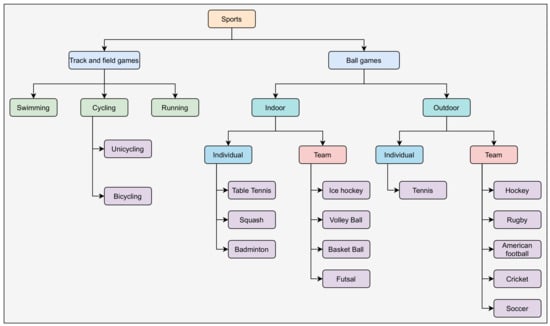
Figure 1.
Classification of different types of sports.
Recent developments in video analysis of sports have a focus on the features of computer vision techniques, which are used to perform certain operations for which these are assigned, such as detailed complex analysis such as detection and classification of each player based on their team in every frame or by recognizing the jersey number to classify players based on their team will help to classify various events where the player is involved. In higher-level analysis, such as tracking the player or ball, many more such evaluations are to be considered for the evaluation of a player’s skills, detecting the team’s strategies, events and the formation of tactical positions such as midfield analysis in various sports such as soccer, basketball, and also various sports vision applications such as smart assistants, virtual umpires, assistance coaches, have been discussed in Section 7. A higher-level semantic interpretation is an effective substitute, especially in situations when reduced human intervention and real-time analysis are desired for the exploitation of the delivered system outputs.
The main task of video summarization or highlight extraction is extracting key events of the game which provides users with an ability to view highlights as per their interests. For this purpose, it is necessary to detect and classify gestures, recognize the actions of the referee/umpire, track players and the ball in key events like the time of goal scoring to analyze and classify different types of shots performed by players. The framework for processing and analyzing task-specific events in sports applications, such as playfield extraction, detection, and tracking of the player/ball is shown in Figure 2, and detailed analyses of playfield extraction are discussed in Section 3.
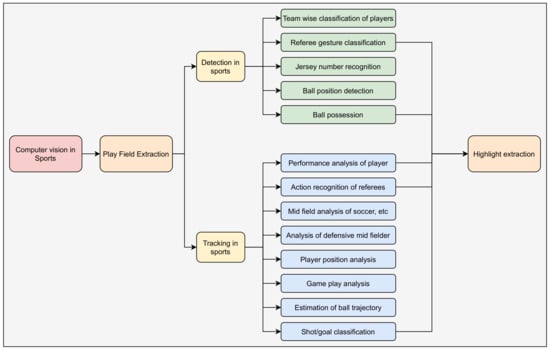
Figure 2.
Framework of processing and analysis of different applications in sports video.
A detailed review of research in the above-mentioned domains is presented in this article and the data were compiled from papers that focus on computer vision-based approaches that were used for each application, followed by inspecting key points and weaknesses, thereby investigating whether these methodologies in their current state of implementation can be utilized in real-time sports video analysis systems.
Features of the Proposed Review
Some of the surveys and reviews published in different sports video processing and their main contributions, i.e., whether the paper discussed (marked as ‘✔’ if discussed in Table 1) hand-crafted and machine learning algorithms, the type of sport, different tasks in sports, whether it provided datasets or not and finally the aim of the review are discussed and summarized in Table 1 and listed below.
- Tan et al. [] researched badminton movement analysis such as Badminton smashing, badminton service recognition, badminton swing, and shuttle trajectory analysis.
- Bonidia et al. [] presented a systematic review of sports data mining, which discusses the current research body, themes, the dataset used, algorithms, and research opportunities.
- Rahmad et al. [] presented a survey on video-based sports intelligence systems used to recognize sports actions. They provided video-based action recognition frameworks used in the sports field and also discussed deep learning implementation in video-based sports action recognition. They proposed a flexible method that classifies actions in different sports with different contexts and features as part of future research.
- Eline and Marco [] presented a summary of 17 human motion capture systems which reports calibration specs as well as the specs provided by the manufacturer. This review helps researchers to select a suitable motion capture system for experimental setups in various sports.
- Ebadi et al. [] presented a survey on state-of-the-art (SOTA) algorithms for player tracking in soccer videos. They analyzed the strengths and weaknesses of different approaches and presented the evaluation criteria for future research.
- Thomas [] proposed an analysis of computer vision-based applications and research topics in the sports field. The study summarized some of the commercially available systems such as camera tracking and player tracking systems. They also incorporated some of the available datasets of different sports.
- Cust et al. [] presented a systematic review on machine learning and deep learning for sports-specific movement recognition using inertial measurement units and computer vision data.
- Kamble et al. [] presented an exhaustive survey on ball tracking categorically and reviewed several used techniques, their performance, advantages, limitations, and their suitability for a different sports.
- Shih [] focused on the content analysis fundamentals (e.g., sports genre classification, the overall status of sports video analytics). Additionally reviewed are SOTA studies with prominent challenges observed in the literature.
- Beal et al. [] explored AI techniques that have been applied to challenges within team sports such as match outcome prediction, tactical decision making, player investments, and injury prediction.
- Apostolidis et al. [] suggested a taxonomy of the existing algorithms and presented a systematic review of the relevant literature that shows the evolution of deep learning-based video summarization technologies.
- Yewande et al. [] explored a review to better understand the usage of wearable technology in sports to improve performance and avoid injury.
- Rana et al. [] offered a thorough overview of the literature on the use of wearable inertial sensors for performance measurement in various sports.

Table 1.
Summary of previous surveys and reviews in different sports.
The proposed survey mainly focuses on providing a proper and comprehensive survey of research carried out in computer vision-based sports video analysis for various applications such as detection and classification of players, tracking players or balls and predicting the trajectories of players or balls, recognizing the team’s strategies, classifying various events on the sports field, etc. and in particular, establishing a pathway for next-generation research in the sports domain. The features of this review are:
- In contrast to recently published review papers in the sports field, this article comprehensively reviews statistics of studies in various sports and various AI algorithms that have been used to cover various aspects observed and verified in sports.
- It provides a roadmap of various AI algorithms’ selection and evaluation criteria and also provide some of the publicly available datasets of different sports.
- It discusses various GPU-based embedded platforms for real-time object detection and tracking framework to improve the performance and accuracy of edge devices.
- Moreover, it demonstrates various applications in sports vision and possible research directions.
The rest of this paper is organized as follows. Section 2 provides statistical details of research in sports. Section 3 presents extraction data vis-a-vis various sports playfields, followed by a broader dimension that covers a wide range of sports and is reviewed in Section 4. Some of the available datasets for various sports along and embedded platforms have been reviewed in Section 5 and Section 6. Section 7 provides various application-specific tasks in the field of sports vision. Section 8 covers potential research directions, as well as different challenges to be overcome in sports studies. Last but not least, Section 9 concludes by describing the final considerations.
2. Statistics of Studies in Sports
Detection of the positions of the players at any given point of time is the basic step for tracking a player, which is also needed for graphics systems in sports for analysis and obtaining pictures of key moments in a game. Equipment and methods used in commercial systems for broadcast analysis vary from those depending on a manual operator clicking on the players’ feet with a calibrated camera image to an automated technique involving segmentation and identification of areas which likely correspond to players. For the performance improvement of sport teams in soccer, volleyball, hockey, badminton among others, analyzing the movements of players individually, and the real-time team formation, may provide a crucial real-time insight for the team coach.
The research articles discussed in this review were obtained from various reputed publishers such as IEEE, Elsevier, MDPI, Springer among many others, and top-tier computer vision conferences such as CVPR, ICCV, and ECCV, ranging from high impact factor online sources in the domain of player/ball/referee detection and tracking in sports, classification of objects in sports, behavior, and performance analysis of players, gesture recognition of referees/umpires, automatic highlight detection, score updating among others. Figure 3 provides overall information of sports research publications in the past five years considered in this comprehensive survey article.
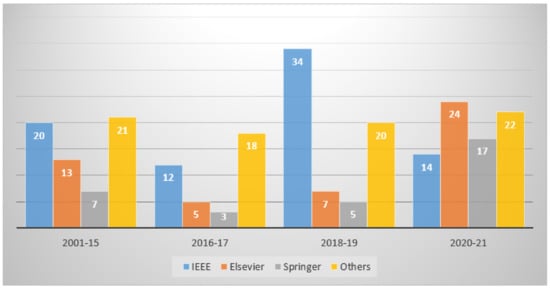
Figure 3.
Sports research progress in past five years.
Figure 4 provides the statistics of studies of various sports in various applications such as detecting/tracking the player and ball, trajectory prediction, classification, and video summarization. which are published in various standard journals as presented in Figure 3.
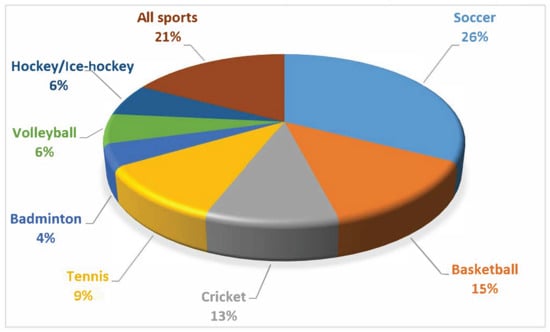
Figure 4.
Sports wise research progress.
3. Play Field Extraction in Various Sports
Detection of the sports field plays an important role in sports video analysis. Detection of the playfield region has two objectives. One is to detect the playfield region from non-playfield areas, while the other is to identify primary objects from the background by filtering out redundant pixels such as grass and court lines. This provides a reduced pixel which requires processing and reduction in errors to simplify player or ball detection and tracking phases, event extraction, pose detection, etc. The challenges here include distinguishing the color of the playfield from that of the stadium, lighting conditions and sometimes weather, viewing angles, and the shadows. Therefore, accurate segmentation of the playfield cannot be achieved just by processing the color of the playfield under certain situations and making it constant without updating the statistics throughout the game. There is also an added noise when the player’s clothes matching that of the ground, and there appear shadows at the base of a player from different sources of light. A Gaussian-based background subtraction technique [], which is implemented using computer vision methods, generates the foreground mask as shown in Figure 5.
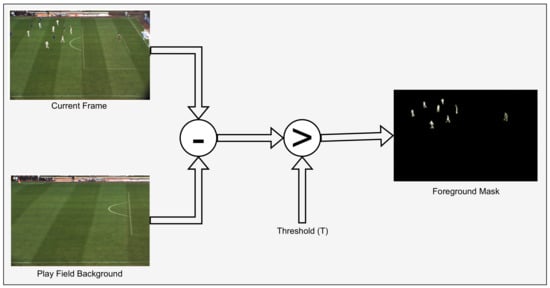
Figure 5.
Background subtraction model.
Researchers have used a single dominant color for detecting the playfield. Accordingly, some studies have utilized the features of images in which illumination is not affected by transforming the images from RGB space to HIS [,,], YCbCr [], normalized RGB [,,].
For a precise capture of the movements of the players, tracking the ball and actions of referees on the field or court, it is necessary to calibrate the camera [,] and also to use an appropriate number of cameras to cover the field. Though some algorithms are capable of tracking the players, some other objects also need to be tracked in dynamically complex situations of interest for detailed analysis of the events and extraction of the data of the subject of interest. Reference [] presented an approach to extract the playing field and track the players and ball using multiple cameras in soccer video. In [,], an architecture was presented, which uses single (Figure 6a) and multi-cameras (Figure 6c) to capture a clear view of players and ball in various challenging and tricky situations such as severe occlusions and the ball being missing from the frames. To estimate the players’ trajectory and team classification in [,] a bird’s eye view of the field is presented to capture players, precisely as shown in Figure 6b. Various positions of the camera for capturing the entire field are presented in [,] to detect and track the players/ball and estimate the position of the players.
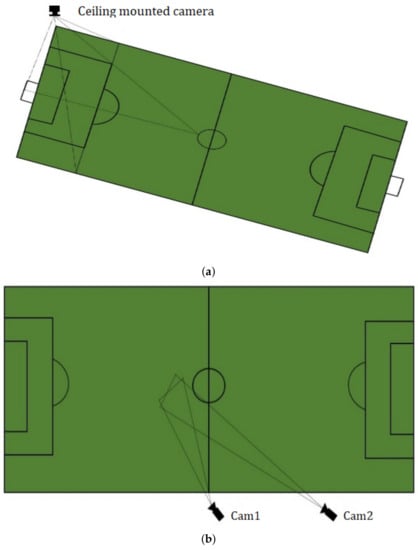
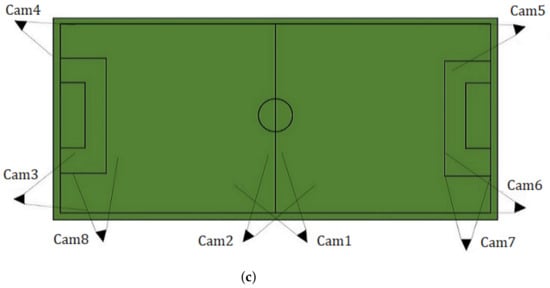
Figure 6.
Camera placements in the playfield. (a) Ceiling-mounted camera []. (b) Birds eye view of the field [,]. (c) Multiple cameras placed to cover the complete playfield [].
Morphological operations-based techniques can separate the playfield and non-playfield regions, but they cannot detect the lines in the playfield. The background subtraction-based techniques generate foreground regions by subtracting the background frame from the current frame (i.e., by detecting moving objects in the frame); however, they fail to detect the playfield lines as shown in Figure 5. So, the best way to detect the playfield lines is by labeling the data as playfield lines (as shown in Figure 7a), advertisements (as shown in Figure 7b), and the non-playfield regions as shown in Figure 7c.
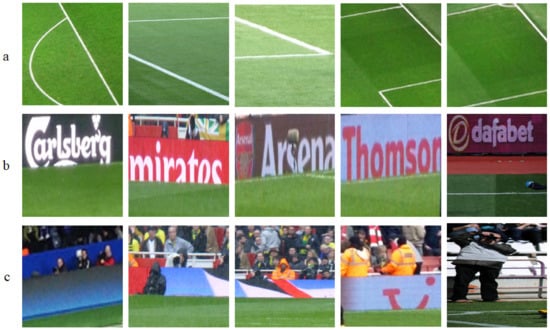
Figure 7.
Background-labeled samples from the dataset (a) playfield lines, (b) advertisements, (c) non-playfield region.
Training the model using a dataset that is labeled as playfield lines, advertisements, and the non-playfield region as shown in Figure 7 can detect and classify the playfield lines, advertisements, and the non-playfield region, which reduces the detection of false positives and false negatives.
4. Literature Review
In this section, the overview of traditional computer-vision methods implemented for major application specifics in sports (such as detection, event classification/recognition, tracking and trajectory prediction) investigated by the researchers and their significant limitations is discussed.
4.1. Basketball
Basketball is a sport played between two teams consisting of five players each. The task of this sport is to score more points than the opponent. This sport has several activities with the ball such as passing, throwing, bouncing, batting, or rolling the ball from one player to another. Physical contact with an opponent player may be a foul if the contact impedes the players’ desired movement. The advancements in computer vision techniques have effectively employed fully automated systems to replace the manual analysis of basketball sports. Recognizing the player’s action and classifying the events [,,] in basketball videos helps to analyze the player’s performance. Player/ball detection and tracking in basketball videos are carried out in [,,,,,] but fail in assigning specific identification to avoid identity switching among the players when they cross. By estimating the pose of the player, the trajectory of the ball [,] is estimated from various distances to the basket. By recognizing and classifying the referee’s signals [], player behavior can be assessed and highlights of the game can be extracted []. The behavior of a basketball team [] can be characterized by the dynamics of space creation presented in [,,,,,] that works to counteract space creation dynamics with a defensive play presented in []. By detecting the specific location of the player and ball in the basketball court, the player movement can be predicted [] and the ball trajectory [,,] can be generated in three dimensions which is a complicated task. It is also necessary to study the extraction of basketball players’ shooting motion trajectory, combined with the image feature analysis method of basketball shooting, to reconstruct and quantitatively track the basketball players’ shooting motion trajectory [,,,]. However, it is difficult to analyze the game data for each play such as the ball tracking or motion of the players in the game, because the situation of the game changes rapidly, and the structure of the data is complicated. Therefore, it is necessary to analyze the real-time gameplay []. Table 2 summarizes various proposed methodologies used to complete various challenging tasks in basketball sport including their limitations.

Table 2.
Studies in basketball.
4.2. Soccer
Soccer is played using football, and eleven players in two teams compete to deliver the ball into the other team’s goal, thereby scoring a goal. The players confuse each other by changing their speed or direction unexpectedly. Due to them having the same jersey color, players look almost identical and are frequently possess the ball, which leads to severe occlusions and tracking ambiguities. In such a case, a jersey number must be detected to recognize the player []. Accurate tracking [,,,,,,,,,,,] by detection [,,,] of multiple soccer players as well as the ball in real-time is a major challenge to evaluate the performance of the players, to find their relative positions at regular intervals, and to link spatiotemporal data to extract trajectories. The systems which evaluate the player [] or team performance [] have the potential to understand the game’s aspects, which are not obvious to the human eye. These systems are able to evaluate the activities of players successfully [] such as the distance covered by players, shot detection [,], the number of sprints, player’s position, and their movements [,], the player’s relative position concerning other players, possession [] of the soccer ball and motion/gesture recognition of the referee [], predicting player trajectories for shot situations []. The generated data can be used to evaluate individual player performance, occlusion handling [] by the detecting position of the player [], action recognition [], predicting and classifying the passes [,,], key event extraction [,,,,,,,,,], tactical performance of the team [,,,,], and analyzing the team’s tactics based on the team formation [,,], along with generating highlights [,,,]. Table 3 summarizes various proposed methodologies to resolve various challenging tasks in soccer with their limitations.

Table 3.
Studies in Soccer.
4.3. Cricket
In many aspects of cricket as well, computer vision techniques can effectively replace manual analysis. A cricket match has many observable elements including batting shots [,,,,,,,], bowling performance [,,,,,], number of runs or score depending on ball movement, detecting and estimating the trajectory of the ball [], decision making on placement of players’ feet [], outcome classification to generate commentary [,], detecting umpire decision [,]. Predicting an individual cricketer’s performance [,] based upon his past record can be critical in team member selection at international competitions. Such process are highly subjective and usually require much expertise and negotiation decision-making. By predicting the results of cricket matches [,,,,] such as the toss decision, home ground, player fitness, player performance criteria [], and other dynamic strategies the winner can be estimated. The video summarization process gives a compact version of the original video for ease in managing the interesting video contents. Moreover, the video summarization methods capture the interest of the viewer by capturing exciting events from the original video [,]. Table 4 summarizes various proposed methodologies with their limitations to resolve various application issues in cricket.

Table 4.
Studies in Cricket.
4.4. Tennis
Worldwide, Tennis has experienced gain a huge popularity. This game need a meticulous analysis to reducing human errors and extracting several statistics from the game’s visual feed. Automated ball and player tracking belongs to such class of systems that requires sophisticated algorithms for analysis. The primary data for tennis are obtained from ball and player tracking systems, such as HawkEye [,] and TennisSense [,]. The data from these systems can be used to detect and track the ball/player [,,,], visualizing the overall tennis match [,] and predicting trajectories of ball landing positions [,,], player activity recognition [,,], analyzing the movements of the player and ball [], analyzing the player behavior [] and predicting the next shot movement [] and real-time tennis swing classification []. Table 5 summarizes various proposed methodologies to resolve various challenging tasks in tennis with their limitations.

Table 5.
Studies in Tennis.
4.5. Volleyball
In volleyball, two teams of six players each are placed on either side of a net. Each team attempts to ground a ball on the opposite team’s court and to score points under the defined rules. So, detecting and analyzing the player activities [,,], detecting play patterns and classifying tactical behaviors [,,,], predicting league standings [], detecting and classifying spiking skills [,], estimating the pose of the player [], tracking the player [], tracking the ball [], etc., are the major aspects of volleyball analysis. Predicting the ball trajectory [] in a volleyball game by observing the motion of the setter player has been conducted. Table 6 summarizes various proposed methodologies to resolve various challenging tasks in volleyball sport with their limitations.

Table 6.
Studies in volleyball.
4.6. Hockey/Ice Hockey
Hockey, also known as Field hockey, is an outdoor game played between two teams of 11 players each. These players use sticks that are curved at the striking end to hit a small and hard ball into their opponent’s goal post. So, detecting [] and tracking the player/hockey ball, recognizing the actions of the player [,,], estimating the pose of the player [], classifying and tracking the players of the same team or different teams [], referee gesture analysis [,] and hockey ball trajectory estimation are the major aspects of hockey sport.
Ice hockey is another similar game to field hockey, with two teams with six players each, wearing skates and competing on an ice rink. All players aim to propel a vulcanized rubber disk, the puck, past a goal line and into a net guarded by a goaltender. Ice hockey is gaining huge popularity on international platforms due to its speed and frequent physical contact. So, detecting/tracking the player [,,], estimating the pose of the player [], classifying and tracking with different identification the players of the same team or different teams, tracking the ice hockey puck [], and classification of puck possession events [] are the major aspects of the ice hockey sport. Table 7 summarizes various proposed methodologies to resolve various challenging tasks in hockey/ice hockey with their limitations.

Table 7.
Studies in hockey.
4.7. Badminton
Badminton is one of the most popular racket sports, which includes tactics, techniques, and precise execution movements. To improve the performance of the player, technology plays a key role in optimizing the training of players; technology determines the movements of the player [] during training and game situations such as with action recognition [,,], analyzing the performance of player [], detecting and tracking the shuttlecock [,,]. Table 8 summarizes various proposed methodologies to resolve various challenging tasks in badminton with their limitations.

Table 8.
Studies in badminton.
4.8. Miscellaneous
Player detection and tracking is the major requirement in athletic sports such as running, swimming [,], and cycling. In sports such as table tennis [], squash [,], and golf [], ball detection and tracking and player pose detection [] are challenging tasks. In ball-centric sports such as rugby, American football, handball, baseball, ball/player detection [,,,,,,] and tracking [,,,,,,,,,], analyzing the action of the player [,,,,,,], event detection and classification [,,,,], performance analysis of player [,,], referee identification and gesture recognition are the major challenging tasks. Video highlight generation is a subclass of video summarization [,,,] which may be viewed as a subclass of sports video analysis. Table 9 summarizes various proposed methodologies to resolve various challenging tasks in various sports with their limitations.

Table 9.
Studies in various sports.
4.9. Overview of Machine Learning/Deep Learning Techniques
There are multiple ways to classify, detect, and track objects to analyze the semantic levels involved in various sports. They pave the way for player localization, jersey number recognition, event classification and trajectory forecasting of the ball in a sports video with a much better interpretation of an image as a whole.
The selected AI algorithm is better if it is tested and benchmarked on different data. To evaluate the robustness of AI algorithms, some metrics are required which measure the performance of particular AI algorithms to enable better selection. Figure 8 depicts the road map of the machine learning algorithms’ general information, methods, and evaluation criteria for a particular task and required libraries/tools for training the model. Figure 9 depicts the roadmap of the deep learning algorithm selection, training, and evaluation criteria for a particular task and required libraries/tools for training the model. Figure 10 shows taxonomy of various deep learning techniques of classification [,,,,,], detection [] and prediction [,,] algorithms, unsupervised learning [,], tracking [,,,,,,,,,], and trajectory prediction [,,,,,,,]. Since various tasks in sports such as classification/detection, tracking, and trajectory prediction show great advantages in various sports. A bi-layered parallel training architecture in distributed computing environments was introduced in [], which discusses the time-consuming training process of large-scale deep learning algorithms.
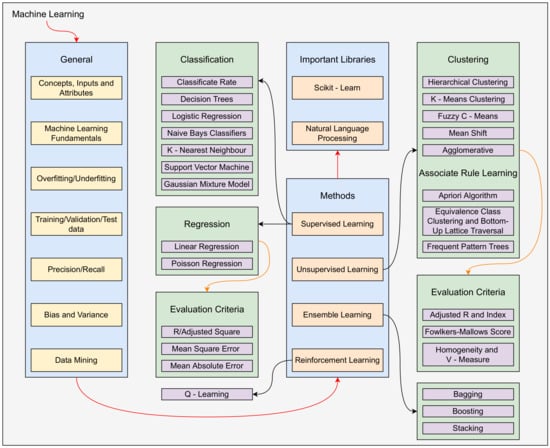
Figure 8.
Block diagram of the road map to machine learning architecture selection and training.
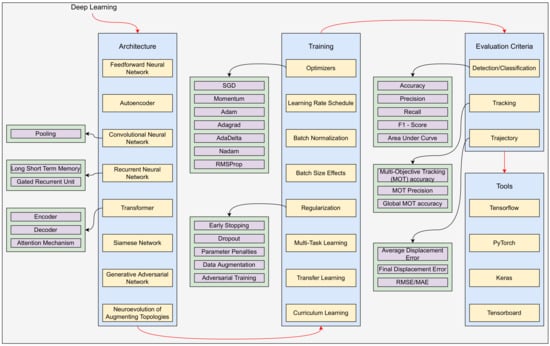
Figure 9.
Block diagram of the road map to deep learning architecture selection and training.
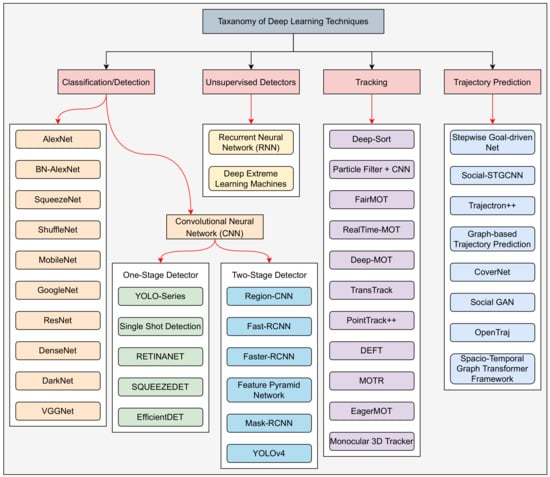
Figure 10.
Overview of deep learning algorithms of classification/detection, tracking and trajectory prediction.
5. Available Datasets of Sports
In this section, a brief description of some sports video datasets which are available publicly with annotations is provided. Utilizing these shared datasets provides a platform for comparison of the performance of algorithms with common data for improving the transparency in research in this domain. Additionally, sharing the data among the users (researchers) reduces time-consuming efforts in capturing and annotating large quantities of videos in diversified areas. This allows users to obtain benchmark scores for the algorithms developed.
These shared datasets can be categorized into two types: videos or still images, which are typically taken with moving cameras, particularly of individual athletes or of team sports, for recognition of player actions [,,,,,,,], event detection and classification [,,], which are often captured using several setups of static cameras, for detection and tracking of players/balls [,,], pose estimation [], and sports event summarization [] of team plays. One dataset is focused on the spectators’ actions in sports rather than those of the players. These datasets which are available for analysis largely perform a great variety of actions. Table 10 describes the available datasets of various sports, the mode of the dataset, annotated parameters, number of frames, and length of the video.

Table 10.
Details of the available datasets.
The parameters which are annotated in the ISSIA dataset relate to the positions of the ball, player, and referee in each video from each camera. The images shown in Figure 11 are a few sample frames from the ISSIA dataset.

Figure 11.
Instances from the ISSIA dataset [].
The parameters which are annotated in the TTNet dataset are the ball bouncing moments, the ball hitting the net, and empty events. The images shown in Figure 12 are a few sample frames from the TTNet dataset.

Figure 12.
Instances from the TTNet dataset [].
For the creation of the APIDIS dataset, videos were captured from seven cameras from above and around the court. The events which are annotated in this dataset are player positions, movements of referees, baskets, and the position of the ball. The images shown in Figure 13 are a few samples from the APIDIS dataset.
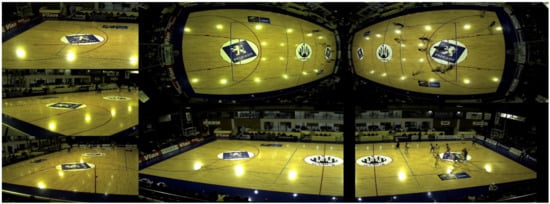
Figure 13.
Instances from the APIDIS dataset [].
6. GPU-Based Work Stations and Embedded Platforms
To find the target, GPU-constrained devices such as Raspberry Pi, Latte Panda, Odroid Xu4 and Computer Vision were used. The disadvantages of machine learning techniques are that they provide poor or inaccurate results and have issues in predicting an unknown future data, whereas deep learning algorithms provide accurate results and also make predictions from unknown future data. Segmentation, localization and image classification are visual recognition systems which have prominent research contributions.
Among embedded AI computing platforms, NVidia Jetson devices provide low-power computing and high-performance support for artificial intelligence-based visual recognition systems. Jetson modules are configured with OpenCV, cuDNN, CUDA Toolkit, L4T with LTS Linux kernel and TensorRT. The Intel Movidius Neural Compute Stick uses the Intel Movidius Neural Compute SDK in GPU-Constrained devices to deploy AI algorithms.
Wang et al. [] presented a high-speed stereo vision system that can track the motion of a golf ball at a speed of 360 km/h under indoor lighting conditions. They implemented the algorithm on a field-programmable gate array board with an advanced RISC machine CPU [] which implemented a deep learning approach to track the soccer ball on NVIDIA GTX1050Ti GPU [] and a deep learning algorithm on GTX 1080 ti GPU, based on CUDA 9.0 and Caffe to analyze the technical features in basketball video. Table 11 shows the basic comparison between GPU-based devices and GPU-Constraint Devices and possible deep learning algorithms to implement on various devices.

Table 11.
Comparison between Jetson Modules and GPU-Constrained Devices.
A Field Programmable Gate Array (FPGA) has also been used in sports involving 3D motion capturing, object movement analysis and image recognition, etc. Table 12 describes how different researchers performed various studies of sports on hardware platforms such as FPGA and GPU-based devices and their results in terms of performance measures are listed.

Table 12.
Performance of various studies on hardware platforms.
7. Applications in Sports Vision
A fan who is digitally connected becomes the biggest online influencer of sports venues. Teams and stadium owners provide plenty of personalized experiences through their custom apps, mobile phone support for content with offers and live updates of game information using digital boards to increase the engagement of fans and in turn generate opportunities for new revenues []. Figure 14 depicts where AI technology can be used within the sporting landscape.
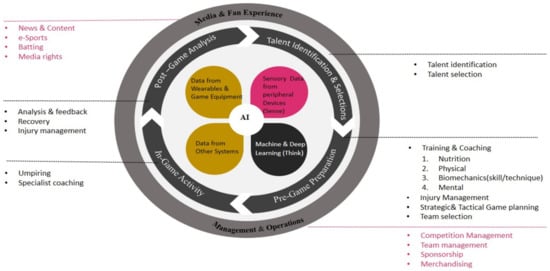
Figure 14.
AI technology framework for the sport industry.
Modern artificial intelligence fields are not good sparring partners, but they can be valuable as research tools. One of the most effective methods to improve this is to learn from one’s failures. The suggested method to improve playing abilities is to review games, but how can one detect the mistakes? How can one come up with better alternatives? This challenge is solved by the field of artificial intelligence analysis tools such as AlphaGO [,,], which provide probability distribution of smart moves and their assessment.
7.1. Chabots and Smart Assistants
Recently, sports bodies such as the NHL and NBA have started using virtual assistants to respond to inquiries made by fans in a wide range of topics such as ticketing, arena logistics, parking, and other game-related information. If the bots are not capable, such scenarios are handled by human intervention and they maintain customer services for that.
7.2. Video Highlights
The challenges facing the industry include not just the creation of content but also delivering it to customers through multiple devices and screens for viewing different content at different times. There is a serious demand from fans for in-depth analysis and also for commentary. Many others like action-packed highlights and some behind-the-scenes content as well. Introducing AI enables the solving of challenging tasks in various sports and it provides an exciting viewing experience to the audience, attracting more viewers.
7.3. Training and Coaching
Effective methods for improving the analysis of the performance of athletes and also assisting coaches with team guidance to gauge the tactics of the opponents are gaining popularity.
An application that uses AI contains huge a dataset of game performances and training-related information, which is backed up with the knowledge of several coaches and sports scientists. They act as an accumulated source of current knowledge on the dissemination of the latest techniques, tactics, or knowledge for professional coaches.
With the evolution of knowledge on any tactic or technique, the knowledge base of AI is updated. The accumulated data can be used for training and educating sports coaches, scientists, and also athletes, which in turn leads to improved performance.
7.4. Virtual Umpires
In cricket and tennis, Video Assistant Referees (VAR) and Decision Review Systems (DRS) have used Hawk-eye, slow-motion replays, and some other technologies. However, the catch is that these involve a request from players or team for review when an umpire’s or referee’s decision has some uncertainty and then involves other parties to assist the main umpire. The whole process is time-consuming and takes away the momentum and excitement of the game.
The latest camera technology supporting AI software creates a situation where an umpire’s role is limited to on-field behavior management of players rather than making critical decisions. For example, in the case of tennis, computer vision is used for detecting placement and speed of the ball; therefore, the need for a line umpire is eliminated. The future scope can be an umpire’s earpiece and glasses assisting the decision instantly and eliminating the necessity of reviews.
7.5. AI Assistant Coaches
AI can be way more capable in situations involving dynamic planning and analysis of the scenes where a coach would rely on previous data and experience, and it is not effective enough to frame dynamically changing strategies in comparison to a machine. A future can be imagined in which a machine with AI running alongside the gameplay dynamically predicts and creates strategies, helping the teams to gain an edge over others.
One example where the evolution of AI can be seen is Chess. The evolution of chess technology is shown in Figure 15. The Russian Garry Kasparov who was considered the world’s number 1 for about 19 years with an Elo rating (skill level measurement) 2851 was surpassed by Magnus Carlsen with Elo rating 2882 in 2014.
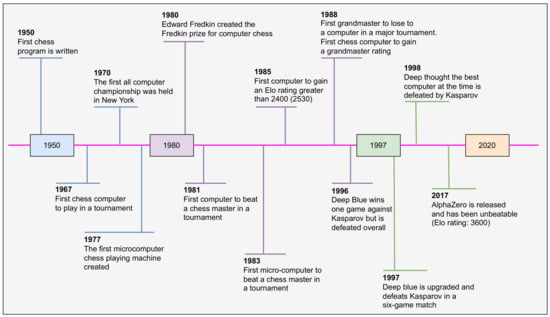
Figure 15.
Evolution of chess technology demonstrates the speed of AI adoption.
In computers, Deep Blue’s rating which was 2700+ was surpassed by Deep Mind’s Alpha Zero with an estimated Elo 3600, which was developed by Google’s sibling DeepMind. It was developed by a reinforcement learning technique called self-play. It took just 24 h to achieve it and proves the capabilities of the machine.
7.6. Available Commercial Systems for Player and Ball Tracking
Hawkeye [,,] is the technology for ball tracking in cricket, tennis, and soccer. The area of primary application is officiating in these sports to enhance broadcast videos. Figure 16 shows the visualization performance of the commercial systems.
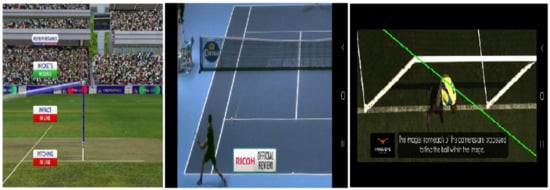
Figure 16.
Hawkeye technology in cricket, tennis and soccer [,,].
STATS SportVU [] and ChyronHego TRACAB [] are the technologies for player tracking in sports. The area of primary application is to track players in various sports, analyze their performance and assist coaches for training. Figure 17 shows the player position and pose estimation using commercial systems. SportsVu is a computer vision technology that provides real-time optical tracking in various sports. It provides in-depth performance of any team, such as tracking every player from both teams to provide comprehensive match coverage, collecting data to provide tactical analysis of the match, and highlighting the performance deviations to reduce injuries in the game.
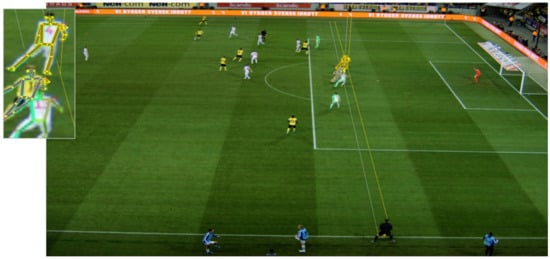
Figure 17.
TRACAB Gen5 Technology for player tracking [].
8. Research Directions in Sports Vision
Based on the investigation of the available articles in sports, we were able to come out with various research topics and identifies research directions to be taken for further research in sports. They are categorized based on the task specifics in sports applications (such as major sports in which player/ball/referee detection and tracking, pose estimation, trajectory prediction are required) as shown in Figure 18 to provide promising and potential research directions for future computer vision/video processing in sports.
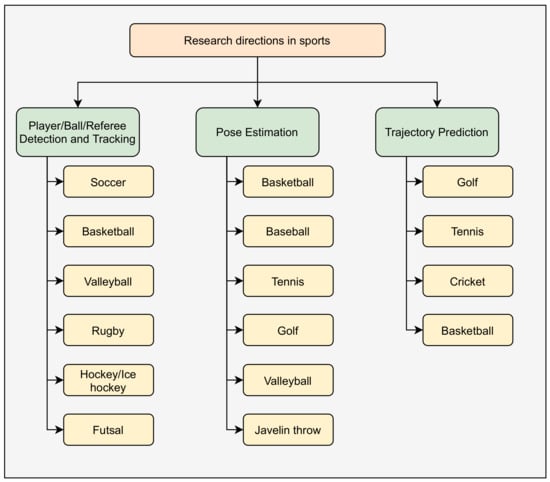
Figure 18.
Major task specifics in sports applications.
As sporting activities are dynamic, the accuracy and reliability of single- or multi-player tracking [,] in real-time sports video can be enhanced by proposing a framework that learns object identities with deep representations which resolve the problem of identity switching among players []. By considering the temporal information, the performance of the tracking algorithm can become robust to overcome problems such as severe occlusions and miss-detection.
The accuracy of classifying different defensive strategies of soccer [] can be improved by labeling large spatio-temporal datasets and by classifying the actions into subtypes []. The performance measures of team tactics analysis [,] of soccer videos can be enhanced by analyzing player trajectories. By incorporating the temporal information, the classification accuracy can be improved while it also offers more specific insights into situations such as pass events in the case of non-obvious insights in soccer videos []. Accurate pose detection as shown in Figure 19a is still a major challenge to identify whether the player is running, jumping, or walking as shown in Figure 19b, and also to handle the severe occlusions or identity switches among players.
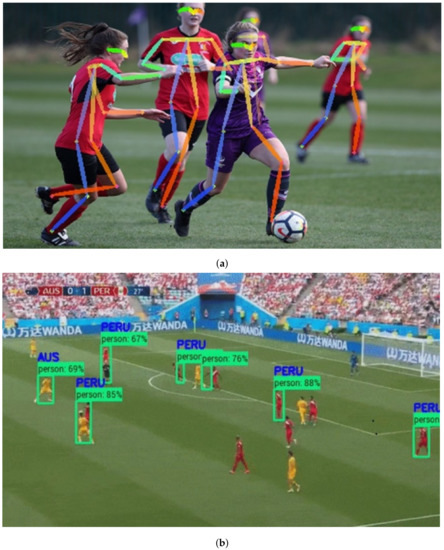
Figure 19.
Instances from soccer matches. (a) Detecting body pose and limbs. (b) Handling severe occlusions among players.
To assess the batter’s caliber, certain aspects of batting need to be considered, i.e., position of batsman before playing a shot, and the method of batting shots for a particular bowling type needs to be modeled []. Classification and summarization techniques can minimize false positives and false negatives to detect and classify umpire poses []. Detecting various moments such as whether the ball hit the bat and precise detection of the player and wicket keeper at the moment of run-outs, as shown in Figure 20a, is still a major issue in cricket. Predicting the trajectory of balls bowled by spin bowlers as shown in Figure 20b can be resolved accurately by labeling large datasets and modeling using SOTA algorithms.
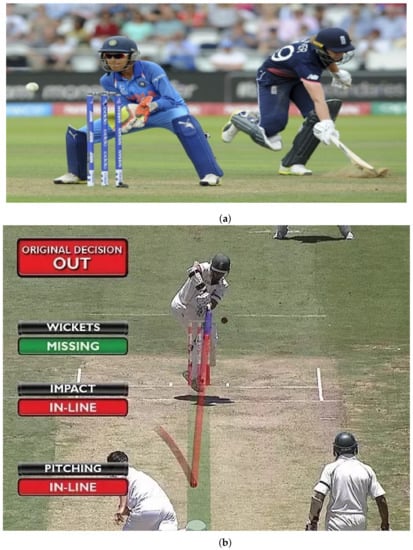
Figure 20.
Instances from cricket matches. (a) Precise detection at the moment of run outs. (b) Predicting the trajectory of the ball in-line or out-line, etc.
The recognition accuracy of player actions in badminton games [] can be improved by SOTA computer vision algorithms and fine-tuning in an end-to-end manner with a larger dataset on features extracted at different fully connected layers. In the implementation of an automatic linesman system in badminton games [], the algorithm is not robust to the far views of the camera, where illumination conditions heavily impact the system while the speed of the shuttlecock is also a major factor for poor accuracy. So, it is necessary to track the path, which becomes simpler for the referee to decide if a shuttle lands out or in as shown in Figure 21.
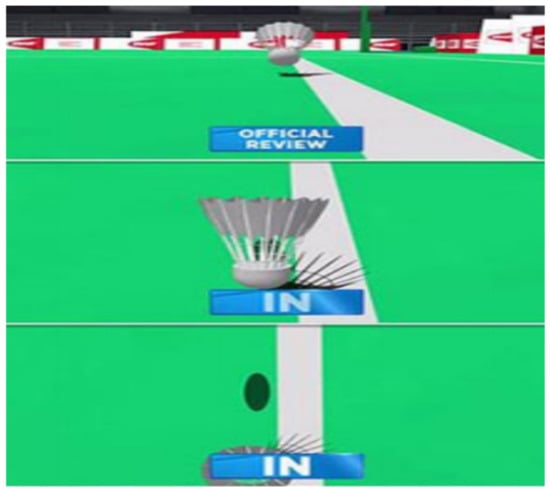
Figure 21.
Exact spot on which the shuttlecock lands.
8.1. Open Issues and Future Research Areas
Computer vision plays a vital role in the area of sports video processing. To analyze sports events, there are many issues open for research. Calibration and viewpoints of the camera to capture the sports events such as close-up views, far views, and wide views in a degree of occlusions are still issues that have not been satisfactorily addressed.
Detecting the ball in various sports helps to detect and classify various ball-based events such as goals, possession of the ball, and many other events. Due to the size, speed, velocity, and unstructured motion of the ball compared to the players and playfield in various sports, it is still an open issue to detect and track the ball. Various AI algorithms have been developed to achieve better performance in various sports such as soccer [,], basketball [,], tennis [], and badminton [,] in terms of detecting and tracking concerning various aspects of the ball.
Tracking players and the ball is one of the most open areas for research which includes various issues such as fast and frequent movements of the players, the similar appearance of players due to jersey color in team sports, often partial and full occlusions of players. Various algorithms use linear motions for multi-player tracking, resulting in poor performance but solves data association problems with appearance models. However, this algorithm fails in various conditions such as severe occlusions, the ambiguity of appearance between players, etc. [,] applied context information to track the players in soccer and volleyball sports.
8.2. Future Research Trends according to Methodologies in Sports Vision
In this section, we aim to set forth the methodological approach to various components of detection, classification, and tracking in sports. By considering the deep analysis of sports studies, it is clear that the performance of the algorithm depends on the type (annotation parameters) of dataset used, which is carried out based on loss functions and evaluation metrics. The major difficulties in the real-time use of AI algorithms in various research areas of sports are accuracy, computation speed, and size of the model. Considering all these aspects, the development of future trends based on contemporary ideas are presented below.
- Due to the continuous movements of the player, jersey numbers encounter serious deformation, and various image sizes and low resolution make it difficult to read the jersey number []. Players’ similar appearances and severe occlusions make it difficult to track and identify players, referees, and goalkeepers reliably, which causes the critical problem of identity switching among players []. To solve these challenges, a framework is needed to propose that learning objects’ identities with deep representations and improve tracking using identity information is necessary.
- The algorithms employed to detect and track the state of the ball such as whether it is controlled by a player (dribbling), moving on the ground (passed from one player to another player), or flying in the air to categorize the movement as a rolling pass or lobbing pass are not robust concerning the size, shape, and velocity of the ball and other parameters under different environmental conditions. A few researchers have come forward with novel ideas to deal with the above-mentioned aspects [,,,,,,]; however, the state-of-the-art research is still at a nascent stage.
- Conventional architectures of detecting, classifying, and tracking are replaced with more promising and potential modern learning paradigms such as Online Learners and Extreme Learning Machines.
- Various activities in sports such as players’ fatigue information can be acquired from wearable sensors and monitoring health conditions of each player in the play-field, tracking players and the ball, predicting the trajectory of the ball, game play analysis and evaluations; identifying players’ actions and other fundamental elements can be accomplished with the help of big data and information technologies. This improves the sports industry’s operational efficiency and leverages its immense potential. Due to advancements in big data analysis [,], and the Internet of Things (IoT) [], personalized care monitoring will become a new direction and breakthrough in the sports industry.
8.3. Different Challenges to Overcome in Sports Studies
- Classification of jersey numbers in sports such as soccer and basketball is quite simple [] as they have plain jerseys, but in the case of the sports such as hockey and American football, the jerseys are massive and have sharp contours. Therefore, jersey number recognition is quite hard. By implementing proper bounding box techniques and digit recognition methods, better performance of jersey number recognition in every sport can be achieved.
- Action recognition in sports videos [,] is explicitly a non-linearity problem, which can be obtained by aligning feature vectors, by providing a massive amount of discriminative video representations. It can provide a method to capture the temporal structure of a video that is not present in the dynamic image space and analyzing salient regions of frames for action recognition.
- Provisional tactical analysis related to player formation in sports such as soccer [], basketball, rugby, American football, and hockey, and pass prediction [,,,], shot prediction [,], the expectation for goals given a game’s state [] or possession of the ball, or more general game strategies, can be achieved through AI algorithms.
- Recognition of the fine-grained activity of typical badminton strokes can be performed by using off-the-shelf sensors [], and it can be replaced with automatic detection and tagging of aspects/events in the game and use of CCTV-grade digital cameras without additional sensors.
- The identity of the player is lost when the player moves out of the frame and, to retain the identity when the players reappear in subsequent frames, the player must be recognized. The key challenges for player recognition are posing variations, i.e., change or rotation of the image in different poses on 2D or 3D perspectives [,], which is the most difficult recognition challenge, especially in case of resolution effects, variable illuminations, or lighting effects and severe occlusions.
9. Conclusions
Sports video analysis is an emerging and very dynamic field of research. This study comprehensively reviewed sports video analysis for various applications such as tracking players or balls in sports and predicting the trajectories of players or balls, players’ skill, and team strategies analysis, detecting and classifying objects in sports. As per the requirements of deploying computer vision techniques in various sports, we provided some of the publicly available datasets related to a particular sport. Detailed discussion on GPU-based work stations, embedded platforms and AI applications in sports are presented. We have present various classical techniques and AI techniques employed in sports, their performance, pros, cons, and suitability to particular sports. We list probable research directions, existing challenges, and current research trends with a brief discussion and also widely used computer vision techniques in various sports.
Individual player tracking in sports is very helpful for coaches and personal trainers. Though the sports include particularly challenging tasks such as similarities between players, generation of blurry video segments in some cases, partial or full occlusions between players, the invisibility of jersey numbers in some cases, computer vision is the best possible solution to achieve player tracking.
Classification of jersey numbers in sports such as soccer and basketball is quite simple as they have plain jerseys, but in the case of sports such as hockey and American football, the jerseys are massive and come with sharp contours, due to which jersey number recognition is quite hard. By implementing proper bounding box techniques and digit recognition methods, better performance vis-a-vis jersey number recognition in every sport can be achieved. As the appearance of players varies from sport to sport, an algorithm trained on one sport may not work when it is tested on another sport. The problem may be solved by considering a dataset that contains a small set of samples from every sport for fine-tuning.
In the case of multi-player tracking in real-time sports videos, severe occlusions cause a critical problem of identity switching among the players. The continuous movement of players makes it difficult to read jersey numbers. A player’s similar appearance to another and severe occlusions make it difficult to track and identify players, referees, and goalkeepers reliably. Multiple object tracking in sports is a key prerequisite for the realization of advanced operations in sports, such as player movement and their position in sports, which will give good objective criteria to the team manager for developing a new plan to improve team performance as well as evaluating each player accurately.
Commercially used multi-camera tracking systems of players rely on some mixtures of manual and automated tracking and player labeling. Optical tracking systems are a good approach for tracking players occluding each other or players with a similar appearance. The algorithm may detect false positives from out of the court such as fans wearing team uniforms, as the appearance of fans is similar to that of players. This can be eliminated by estimating the play area or broadcast camera parameters with extra spatiotemporal locations of player positions.
Action recognition in sports videos is explicitly a non-linearity problem, which can be obtained by aligning feature vectors, by providing a massive amount discriminative video representations to capture the temporal structure of the video that is not present in the dynamic image space and analyzing the salient regions of the frames for action recognition.
The algorithms employed so far for detecting and tracking ball movements began with estimating the 3D ball position in trajectory. Employing these methods is very critical, as they include a lot of mathematical relations and require reliable reference objects to construct the path of the trajectory. Kalman filter- and particle filter-based methods are robust concerning the size, shape, and velocity of the ball. However, the methods fail to establish the track when the ball reappears after occlusion. Trajectory-based methods solve the problem of occlusion and are robust in obtaining data regarding missing and merging balls but fail to obtain data regarding the case of the size and shape of the ball. Data association methods are best suited for detecting and tracking small size balls in small courts such as tennis courts but are not suited for challenges in sports such as basketball, soccer, and volleyball. AI algorithms predict the precise trajectories of the ball from a knowledge of previous frames and are immune to challenges such as air friction, ball spin, and other complex ball movements. A precise database that includes different sizes and shapes of the ball has to be introduced to detect the ball position and enable tracking algorithms to perform efficiently.
Detection and tracking of players, balls and assistant referee as well as semantic scene understanding in computer vision applications of sports is still an open research area due to various challenges such as sudden and rapid changes in movements of the players and ball, similar appearance, players with extreme aspect ratios (players have extremely small aspect ratios in terms of height and width when they fall down on the field) and frequent occlusions. The future scope of computer vision research in sports, therefore, is handling limitations more accurately on different AI algorithms.
As the betting process involves financial assets, it is important to decide which team is likely to win; therefore, bookmakers, fans, and potential bidders are all interested in estimating the odds of the game in advance. So, provisional tactical analysis of field sports related to player formation in sports such as soccer, basketball, rugby, American football, and hockey, as well as pass prediction, shot prediction, and expectations of goals in a given game state or a possession, or more general game strategies, need to be analyzed in advance.
Tracking algorithms that are used in various sports cannot be compared on a common scale as experiments, requirements, situations, and infrastructure in every scenario differ. Determining the performance benchmark of algorithms quantitatively is quite difficult due to the unavailability of a comparable database with ground truths of different sports differing in many aspects. In addition to these, there are additional parameters such as different video capturing devices and their parameter variations which lead to difficulty in building an object tracking system in the sports field.
Author Contributions
Conceptualization, B.T.N. and M.F.H.; methodology, B.T.N. and M.F.H.; software, B.T.N.; validation, B.T.N., M.F.H. and N.D.B.; formal analysis, B.T.N. and M.F.H.; investigation, B.T.N., M.F.H. and N.D.B.; resources, M.F.H. and N.D.B.; data curation, B.T.N. and M.F.H.; writing—original draft preparation, B.T.N., M.F.H. and N.D.B.; writing—review and editing, B.T.N., M.F.H. and N.D.B.; visualization, B.T.N. and N.D.B.; supervision, M.F.H. and N.D.B.; project administration, M.F.H. and N.D.B.; funding acquisition, M.F.H. and N.D.B. All authors have read and agreed to the published version of the manuscript.
Funding
This research received no external funding.
Institutional Review Board Statement
Not applicable.
Informed Consent Statement
Not applicable.
Data Availability Statement
The data presented in this study are available on request from the corresponding author.
Conflicts of Interest
The authors declare no conflict of interest.
Abbreviations
The following abbreviations are used in this manuscript:
| ANN | Artificial Neural Network |
| AI | Artificial intelligence |
| AUC | Area under Curve |
| BEI-CNN | Basketball Energy Image - Convolutional Neural Network |
| Bi-LSTM | Bi-directional Long Short Term Memory |
| CNN | Convolutional Neural Network |
| CPU | Central Processing Unit |
| CUDA | Compute Unified Device Architecture |
| DELM | Deep Extreme Learning Machine |
| DeepMOT | Deep Multi Object Tracking |
| Deep-SORT | Simple Online Real Time Tracking with Deep Association |
| DRS | Decision Review System |
| ELM | Extreme Learning Machine |
| Faster-RCNN | Faster-Regional with Convolutional Neural Network |
| FPGA | Field Programmable Gate Array |
| GAN | Generative Adversarial Network |
| GDA | Gaussian Discriminant Analysis |
| GPU | Graphical Processing Unit |
| GRU-CNN | Gated Recurrent Unit - Convolutional Neural Network |
| GTX | Giga Texel Shader eXtreme |
| HOG | Histogram of Oriented Gradients |
| HPN | Hierarchical Policy Network |
| KNN | K-Nearest Neighbor |
| LSTM | Long Short Term Memory |
| Mask R-CNN | Mask Region-based Convolutional Neural Network |
| NBA | National Basketball Association |
| NHL | National Hockey League |
| R-CNN | Region-based Convolutional Neural Network |
| ResNet | Residual neural Network |
| RISC | Reduced Instruction Set Computer |
| RNN | Recurrent Neural Networks |
| SOTA | State-of-the-art |
| SSD | Single-Shot Detector |
| SVM | Support Vector Machine |
| VAR | Video Assistant Referee |
| VGG | Visual Geometry Group |
| YOLO | You Only Look Once |
References
- Tan, D.; Ting, H.; Lau, S. A review on badminton motion analysis. In Proceedings of the International Conference on Robotics, Automation and Sciences (ICORAS), Melaka, Malaysia, 5–6 November 2016; pp. 1–4. [Google Scholar]
- Bonidia, R.P.; Rodrigues, L.A.; Avila-Santos, A.P.; Sanches, D.S.; Brancher, J.D. Computational intelligence in sports: A systematic literature review. Adv. Hum.-Comput. Interact. 2018, 2018, 3426178. [Google Scholar] [CrossRef]
- Rahmad, N.A.; As’ari, M.A.; Ghazali, N.F.; Shahar, N.; Sufri, N.A.J. A survey of video based action recognition in sports. Indones. J. Electr. Eng. Comput. Sci. 2018, 11, 987–993. [Google Scholar] [CrossRef]
- Van der Kruk, E.; Reijne, M.M. Accuracy of human motion capture systems for sport applications; state-of-the-art review. Eur. J. Sport Sci. 2018, 18, 806–819. [Google Scholar] [CrossRef] [PubMed]
- Manafifard, M.; Ebadi, H.; Moghaddam, H.A. A survey on player tracking in soccer videos. Comput. Vis. Image Underst. 2017, 159, 19–46. [Google Scholar] [CrossRef]
- Thomas, G.; Gade, R.; Moeslund, T.B.; Carr, P.; Hilton, A. Computer vision for sports: Current applications and research topics. Comput. Vis. Image Underst. 2017, 159, 3–18. [Google Scholar] [CrossRef]
- Cust, E.E.; Sweeting, A.J.; Ball, K.; Robertson, S. Machine and deep learning for sport-specific movement recognition: A systematic review of model development and performance. J. Sports Sci. 2019, 37, 568–600. [Google Scholar] [CrossRef]
- Kamble, P.R.; Keskar, A.G.; Bhurchandi, K.M. Ball tracking in sports: A survey. Artif. Intell. Rev. 2019, 52, 1655–1705. [Google Scholar] [CrossRef]
- Shih, H.C. A survey of content-aware video analysis for sports. IEEE Trans. Circuits Syst. Video Technol. 2017, 28, 1212–1231. [Google Scholar] [CrossRef] [Green Version]
- Beal, R.; Norman, T.J.; Ramchurn, S.D. Artificial intelligence for team sports: A survey. Knowl. Eng. Rev. 2019, 34, e28. [Google Scholar] [CrossRef]
- Apostolidis, E.; Adamantidou, E.; Metsai, A.I.; Mezaris, V.; Patras, I. Video Summarization Using Deep Neural Networks: A Survey. Proc. IEEE 2021, 109, 1838–1863. [Google Scholar] [CrossRef]
- Adesida, Y.; Papi, E.; McGregor, A.H. Exploring the role of wearable technology in sport kinematics and kinetics: A systematic review. Sensors 2019, 19, 1597. [Google Scholar] [CrossRef] [PubMed] [Green Version]
- Rana, M.; Mittal, V. Wearable sensors for real-time kinematics analysis in sports: A review. IEEE Sens. J. 2020, 21, 1187–1207. [Google Scholar] [CrossRef]
- Kini, S. Real Time Moving Vehicle Congestion Detection and Tracking using OpenCV. Turk. J. Comput. Math. Educ. 2021, 12, 273–279. [Google Scholar]
- Davis, M. Investigation into Tracking Football Players from Single Viewpoint Video Sequences. Bachelor’s Thesis, The University of Bath, Bath, UK, 2008; p. 147. [Google Scholar]
- Spagnolo, P.; Mosca, N.; Nitti, M.; Distante, A. An unsupervised approach for segmentation and clustering of soccer players. In Proceedings of the International Machine Vision and Image Processing Conference (IMVIP 2007), Washington, DC, USA, 5–7 September 2007; pp. 133–142. [Google Scholar]
- Le Troter, A.; Mavromatis, S.; Sequeira, J. Soccer field detection in video images using color and spatial coherence. In Proceedings of the International Conference Image Analysis and Recognition, Porto, Portugal, 29 September–1 October 2004; pp. 265–272. [Google Scholar]
- Heydari, M.; Moghadam, A.M.E. An MLP-based player detection and tracking in broadcast soccer video. In Proceedings of the International Conference of Robotics and Artificial Intelligence, Rawalpindi, Pakistan, 22–23 October 2012; pp. 195–199. [Google Scholar]
- Barnard, M.; Odobez, J.M. Robust playfield segmentation using MAP adaptation. In Proceedings of the 17th International Conference on Pattern Recognition, Cambridge, UK, 26 August 2004; Volume 3, pp. 610–613. [Google Scholar]
- Pallavi, V.; Mukherjee, J.; Majumdar, A.K.; Sural, S. Graph-based multiplayer detection and tracking in broadcast soccer videos. IEEE Trans. Multimed. 2008, 10, 794–805. [Google Scholar] [CrossRef]
- Ul Huda, N.; Jensen, K.H.; Gade, R.; Moeslund, T.B. Estimating the number of soccer players using simulation-based occlusion handling. In Proceedings of the IEEE Conference on Computer Vision and Pattern Recognition Workshops, Salt Lake City, UT, USA, 18–22 June 2018; pp. 1824–1833. [Google Scholar]
- Ohno, Y.; Miura, J.; Shirai, Y. Tracking players and estimation of the 3D position of a ball in soccer games. In Proceedings of the 15th International Conference on Pattern Recognition, Barcelona, Spain, 3–7 September 2000; pp. 145–148. [Google Scholar]
- Santiago, C.B.; Sousa, A.; Reis, L.P.; Estriga, M.L. Real time colour based player tracking in indoor sports. In Computational Vision and Medical Image Processing; Springer: Berlin/Heidelberg, Germany, 2011; pp. 17–35. [Google Scholar]
- Ren, J.; Orwell, J.; Jones, G.A.; Xu, M. Tracking the soccer ball using multiple fixed cameras. Comput. Vis. Image Underst. 2009, 113, 633–642. [Google Scholar] [CrossRef] [Green Version]
- Kasuya, N.; Kitahara, I.; Kameda, Y.; Ohta, Y. Real-time soccer player tracking method by utilizing shadow regions. In Proceedings of the 18th ACM International Conference on Multimedia, Firenze, Italy, 25–29 October 2010; pp. 1319–1322. [Google Scholar]
- Homayounfar, N.; Fidler, S.; Urtasun, R. Sports field localization via deep structured models. In Proceedings of the IEEE Conference on Computer Vision and Pattern Recognition, Honolulu, HI, USA, 21–26 June 2017; pp. 5212–5220. [Google Scholar]
- Leo, M.; Mosca, N.; Spagnolo, P.; Mazzeo, P.L.; D’Orazio, T.; Distante, A. Real-time multiview analysis of soccer matches for understanding interactions between ball and players. In Proceedings of the 2008 International Conference on Content-Based Image and Video Retrieval, Niagara Falls, ON, Canada, 7–9 July 2008; pp. 525–534. [Google Scholar]
- Conaire, C.O.; Kelly, P.; Connaghan, D.; O’Connor, N.E. Tennissense: A platform for extracting semantic information from multi-camera tennis data. In Proceedings of the 16th International Conference on Digital Signal Processing, Santorini, Greece, 5–7 July 2009; pp. 1–6. [Google Scholar]
- Wu, L.; Yang, Z.; He, J.; Jian, M.; Xu, Y.; Xu, D.; Chen, C.W. Ontology-based global and collective motion patterns for event classification in basketball videos. IEEE Trans. Circuits Syst. Video Technol. 2019, 30, 2178–2190. [Google Scholar] [CrossRef] [Green Version]
- Wu, L.; Yang, Z.; Wang, Q.; Jian, M.; Zhao, B.; Yan, J.; Chen, C.W. Fusing motion patterns and key visual information for semantic event recognition in basketball videos. Neurocomputing 2020, 413, 217–229. [Google Scholar] [CrossRef]
- Liu, L. Objects detection toward complicated high remote basketball sports by leveraging deep CNN architecture. Future Gener. Comput. Syst. 2021, 119, 31–36. [Google Scholar] [CrossRef]
- Fu, X.; Zhang, K.; Wang, C.; Fan, C. Multiple player tracking in basketball court videos. J. Real-Time Image Process. 2020, 17, 1811–1828. [Google Scholar] [CrossRef]
- Yoon, Y.; Hwang, H.; Choi, Y.; Joo, M.; Oh, H.; Park, I.; Lee, K.H.; Hwang, J.H. Analyzing basketball movements and pass relationships using realtime object tracking techniques based on deep learning. IEEE Access 2019, 7, 56564–56576. [Google Scholar] [CrossRef]
- Ramanathan, V.; Huang, J.; Abu-El-Haija, S.; Gorban, A.; Murphy, K.; Fei-Fei, L. Detecting events and key actors in multi-person videos. In Proceedings of the IEEE Conference on Computer Vision and Pattern Recognition, Las Vegas, NV, USA, 27–30 June 2016; pp. 3043–3053. [Google Scholar]
- Chakraborty, B.; Meher, S. A real-time trajectory-based ball detection-and-tracking framework for basketball video. J. Opt. 2013, 42, 156–170. [Google Scholar] [CrossRef]
- Santhosh, P.; Kaarthick, B. An automated player detection and tracking in basketball game. Comput. Mater. Contin. 2019, 58, 625–639. [Google Scholar]
- Acuna, D. Towards real-time detection and tracking of basketball players using deep neural networks. In Proceedings of the 31st Conference on Neural Information Processing Systems (NIPS 2017), Long Beach, CA, USA, 4–9 December 2017; pp. 4–9. [Google Scholar]
- Zhao, Y.; Yang, R.; Chevalier, G.; Shah, R.C.; Romijnders, R. Applying deep bidirectional LSTM and mixture density network for basketball trajectory prediction. Optik 2018, 158, 266–272. [Google Scholar] [CrossRef] [Green Version]
- Shah, R.; Romijnders, R. Applying Deep Learning to Basketball Trajectories. arXiv 2016, arXiv:1608.03793. [Google Scholar]
- Žemgulys, J.; Raudonis, V.; Maskeliūnas, R.; Damaševičius, R. Recognition of basketball referee signals from real-time videos. J. Ambient Intell. Humaniz. Comput. 2020, 11, 979–991. [Google Scholar] [CrossRef]
- Liu, W.; Yan, C.C.; Liu, J.; Ma, H. Deep learning based basketball video analysis for intelligent arena application. Multimed. Tools Appl. 2017, 76, 24983–25001. [Google Scholar] [CrossRef]
- Yao, P. Real-Time Analysis of Basketball Sports Data Based on Deep Learning. Complexity 2021, 2021, 9142697. [Google Scholar] [CrossRef]
- Chen, L.; Wang, W. Analysis of technical features in basketball video based on deep learning algorithm. Signal Process. Image Commun. 2020, 83, 115786. [Google Scholar] [CrossRef]
- Wang, K.C.; Zemel, R. Classifying NBA offensive plays using neural networks. In Proceedings of the Proceedings of MIT Sloan Sports Analytics Conference, Boston, MA, USA, 11–12 March 2016; Volume 4, pp. 1–9. [Google Scholar]
- Tsai, T.Y.; Lin, Y.Y.; Jeng, S.K.; Liao, H.Y.M. End-to-End Key-Player-Based Group Activity Recognition Network Applied to Basketball Offensive Tactic Identification in Limited Data Scenarios. IEEE Access 2021, 9, 104395–104404. [Google Scholar] [CrossRef]
- Lamas, L.; Junior, D.D.R.; Santana, F.; Rostaiser, E.; Negretti, L.; Ugrinowitsch, C. Space creation dynamics in basketball offence: Validation and evaluation of elite teams. Int. J. Perform. Anal. Sport 2011, 11, 71–84. [Google Scholar] [CrossRef]
- Bourbousson, J.; Sève, C.; McGarry, T. Space–time coordination dynamics in basketball: Part 1. Intra-and inter-couplings among player dyads. J. Sports Sci. 2010, 28, 339–347. [Google Scholar] [CrossRef] [PubMed]
- Bourbousson, J.; Seve, C.; McGarry, T. Space–time coordination dynamics in basketball: Part 2. The interaction between the two teams. J. Sports Sci. 2010, 28, 349–358. [Google Scholar] [CrossRef] [PubMed]
- Tian, C.; De Silva, V.; Caine, M.; Swanson, S. Use of machine learning to automate the identification of basketball strategies using whole team player tracking data. Appl. Sci. 2020, 10, 24. [Google Scholar] [CrossRef] [Green Version]
- Hauri, S.; Djuric, N.; Radosavljevic, V.; Vucetic, S. Multi-Modal Trajectory Prediction of NBA Players. In Proceedings of the IEEE/CVF Winter Conference on Applications of Computer Vision, Waikoloa, HI, USA, 3–8 January 2021; pp. 1640–1649. [Google Scholar]
- Zheng, S.; Yue, Y.; Lucey, P. Generating Long-Term Trajectories Using Deep Hierarchical Networks. In Proceedings of the 30th International Conference on Neural Information Processing Systems, Barcelona, Spain, 5–10 December 2016; pp. 1551–1559. [Google Scholar]
- Bertugli, A.; Calderara, S.; Coscia, P.; Ballan, L.; Cucchiara, R. AC-VRNN: Attentive Conditional-VRNN for multi-future trajectory prediction. Comput. Vis. Image Underst. 2021, 210, 103245. [Google Scholar] [CrossRef]
- Victor, B.; Nibali, A.; He, Z.; Carey, D.L. Enhancing trajectory prediction using sparse outputs: Application to team sports. Neural Comput. Appl. 2021, 33, 11951–11962. [Google Scholar] [CrossRef]
- Li, H.; Zhang, M. Artificial Intelligence and Neural Network-Based Shooting Accuracy Prediction Analysis in Basketball. Mob. Inf. Syst. 2021, 2021, 4485589. [Google Scholar] [CrossRef]
- Chen, H.T.; Chou, C.L.; Fu, T.S.; Lee, S.Y.; Lin, B.S.P. Recognizing tactic patterns in broadcast basketball video using player trajectory. J. Vis. Commun. Image Represent. 2012, 23, 932–947. [Google Scholar] [CrossRef]
- Chen, H.T.; Tien, M.C.; Chen, Y.W.; Tsai, W.J.; Lee, S.Y. Physics-based ball tracking and 3D trajectory reconstruction with applications to shooting location estimation in basketball video. J. Vis. Commun. Image Represent. 2009, 20, 204–216. [Google Scholar] [CrossRef]
- Hu, M.; Hu, Q. Design of basketball game image acquisition and processing system based on machine vision and image processor. Microprocess. Microsyst. 2021, 82, 103904. [Google Scholar] [CrossRef]
- Yichen, W.; Yamashita, H. Lineup Optimization Model of Basketball Players Based on the Prediction of Recursive Neural Networks. Int. J. Econ. Manag. Eng. 2021, 15, 283–289. [Google Scholar]
- Suda, S.; Makino, Y.; Shinoda, H. Prediction of volleyball trajectory using skeletal motions of setter player. In Proceedings of the 10th Augmented Human International Conference, Reims, France, 11–12 March 2019; pp. 1–8. [Google Scholar]
- Gerke, S.; Linnemann, A.; Müller, K. Soccer player recognition using spatial constellation features and jersey number recognition. Comput. Vis. Image Underst. 2017, 159, 105–115. [Google Scholar] [CrossRef]
- Baysal, S.; Duygulu, P. Sentioscope: A soccer player tracking system using model field particles. IEEE Trans. Circuits Syst. Video Technol. 2015, 26, 1350–1362. [Google Scholar] [CrossRef]
- Kamble, P.; Keskar, A.; Bhurchandi, K. A deep learning ball tracking system in soccer videos. Opto-Electron. Rev. 2019, 27, 58–69. [Google Scholar] [CrossRef]
- Choi, K.; Seo, Y. Automatic initialization for 3D soccer player tracking. Pattern Recognit. Lett. 2011, 32, 1274–1282. [Google Scholar] [CrossRef]
- Kim, W. Multiple object tracking in soccer videos using topographic surface analysis. J. Vis. Commun. Image Represent. 2019, 65, 102683. [Google Scholar] [CrossRef]
- Liu, J.; Tong, X.; Li, W.; Wang, T.; Zhang, Y.; Wang, H. Automatic player detection, labeling and tracking in broadcast soccer video. Pattern Recognit. Lett. 2009, 30, 103–113. [Google Scholar] [CrossRef]
- Komorowski, J.; Kurzejamski, G.; Sarwas, G. BallTrack: Football ball tracking for real-time CCTV systems. In Proceedings of the 16th International Conference on Machine Vision Applications (MVA), Tokyo, Japan, 27–31 May 2019; pp. 1–5. [Google Scholar]
- Hurault, S.; Ballester, C.; Haro, G. Self-Supervised Small Soccer Player Detection and Tracking. In Proceedings of the 3rd International Workshop on Multimedia Content Analysis in Sports, Seattle, WA, USA, 12–16 October 2020; pp. 9–18. [Google Scholar]
- Kamble, P.R.; Keskar, A.G.; Bhurchandi, K.M. A convolutional neural network based 3D ball tracking by detection in soccer videos. In Proceedings of the Eleventh International Conference on Machine Vision (ICMV 2018), Munich, Germany, 1–3 November 2018; Volume 11041, p. 110412O. [Google Scholar]
- Naidoo, W.C.; Tapamo, J.R. Soccer video analysis by ball, player and referee tracking. In Proceedings of the 2006 Annual Research Conference of the South African Institute of Computer Scientists and Information Technologists on IT Research in Developing Countries, Somerset West, South Africa, 9–11 October 2006; pp. 51–60. [Google Scholar]
- Liang, D.; Liu, Y.; Huang, Q.; Gao, W. A scheme for ball detection and tracking in broadcast soccer video. In Proceedings of the Pacific-Rim Conference on Multimedia, Jeju Island, Korea, 13–16 November 2005; pp. 864–875. [Google Scholar]
- Naik, B.; Hashmi, M.F. YOLOv3-SORT detection and tracking player-ball in soccer sport. J. Electron. Imaging 2022, 32, 011003. [Google Scholar] [CrossRef]
- Naik, B.; Hashmi, M.F.; Geem, Z.W.; Bokde, N.D. DeepPlayer-Track: Player and Referee Tracking with Jersey Color Recognition in Soccer. IEEE Access 2022, 10, 32494–32509. [Google Scholar] [CrossRef]
- Komorowski, J.; Kurzejamski, G.; Sarwas, G. FootAndBall: Integrated Player and Ball Detector. In Proceedings of the 15th International Joint Conference on Computer Vision, Imaging and Computer Graphics Theory and Applications, Valletta, Malta, 27–29 February 2020; Volume 5, pp. 47–56. [Google Scholar] [CrossRef]
- Pallavi, V.; Mukherjee, J.; Majumdar, A.K.; Sural, S. Ball detection from broadcast soccer videos using static and dynamic features. J. Vis. Commun. Image Represent. 2008, 19, 426–436. [Google Scholar] [CrossRef]
- Leo, M.; Mazzeo, P.L.; Nitti, M.; Spagnolo, P. Accurate ball detection in soccer images using probabilistic analysis of salient regions. Mach. Vis. Appl. 2013, 24, 1561–1574. [Google Scholar] [CrossRef]
- Mazzeo, P.L.; Leo, M.; Spagnolo, P.; Nitti, M. Soccer ball detection by comparing different feature extraction methodologies. Adv. Artif. Intell. 2012, 2012, 512159. [Google Scholar] [CrossRef]
- Garnier, P.; Gregoir, T. Evaluating Soccer Player: From Live Camera to Deep Reinforcement Learning. arXiv 2021, arXiv:2101.05388. [Google Scholar]
- Kusmakar, S.; Shelyag, S.; Zhu, Y.; Dwyer, D.; Gastin, P.; Angelova, M. Machine Learning Enabled Team Performance Analysis in the Dynamical Environment of Soccer. IEEE Access 2020, 8, 90266–90279. [Google Scholar] [CrossRef]
- Baccouche, M.; Mamalet, F.; Wolf, C.; Garcia, C.; Baskurt, A. Action classification in soccer videos with long short-term memory recurrent neural networks. In Proceedings of the International Conference on Artificial Neural Networks, Thessaloniki, Greece, 15–18 September 2010; pp. 154–159. [Google Scholar]
- Jackman, S. Football Shot Detection Using Convolutional Neural Networks. Master’s Thesis, Department of Biomedical Engineering, Linköping University, Linköping, Sweden, 2019. [Google Scholar]
- Lucey, P.; Bialkowski, A.; Monfort, M.; Carr, P.; Matthews, I. quality vs quantity: Improved shot prediction in soccer using strategic features from spatiotemporal data. In Proceedings of the 8th Annual MIT Sloan Sports Analytics Conference, Boston, MA, USA, 28 February–1 March 2014; pp. 1–9. [Google Scholar]
- Cioppa, A.; Deliege, A.; Giancola, S.; Ghanem, B.; Droogenbroeck, M.V.; Gade, R.; Moeslund, T.B. A context-aware loss function for action spotting in soccer videos. In Proceedings of the IEEE/CVF Conference on Computer Vision and Pattern Recognition, Seattle, WA, USA, 13–19 June 2020; pp. 13126–13136. [Google Scholar]
- Beernaerts, J.; De Baets, B.; Lenoir, M.; Van de Weghe, N. Spatial movement pattern recognition in soccer based on relative player movements. PLoS ONE 2020, 15, e0227746. [Google Scholar] [CrossRef] [PubMed]
- Barbon Junior, S.; Pinto, A.; Barroso, J.V.; Caetano, F.G.; Moura, F.A.; Cunha, S.A.; Torres, R.d.S. Sport action mining: Dribbling recognition in soccer. Multimed. Tools Appl. 2022, 81, 4341–4364. [Google Scholar] [CrossRef]
- Kim, Y.; Jung, C.; Kim, C. Motion Recognition of Assistant Referees in Soccer Games via Selective Color Contrast Revelation. EasyChair Preprint no. 2604, EasyChair. 2020. Available online: https://easychair.org/publications/preprint/z975 (accessed on 2 November 2021).
- Lindström, P.; Jacobsson, L.; Carlsson, N.; Lambrix, P. Predicting player trajectories in shot situations in soccer. In Proceedings of the International Workshop on Machine Learning and Data Mining for Sports Analytics, Ghent, Belgium, 14–18 September 2020; pp. 62–75. [Google Scholar]
- Machado, V.; Leite, R.; Moura, F.; Cunha, S.; Sadlo, F.; Comba, J.L. Visual soccer match analysis using spatiotemporal positions of players. Comput. Graph. 2017, 68, 84–95. [Google Scholar] [CrossRef]
- Ganesh, Y.; Teja, A.S.; Munnangi, S.K.; Murthy, G.R. A Novel Framework for Fine Grained Action Recognition in Soccer. In Proceedings of the International Work-Conference on Artificial Neural Networks, Munich, Germany, 17–19 September 2019; pp. 137–150. [Google Scholar]
- Chawla, S.; Estephan, J.; Gudmundsson, J.; Horton, M. Classification of passes in football matches using spatiotemporal data. ACM Trans. Spat. Algorithms Syst. 2017, 3, 1–30. [Google Scholar] [CrossRef] [Green Version]
- Gyarmati, L.; Stanojevic, R. QPass: A Merit-based Evaluation of Soccer Passes. arXiv 2016, arXiv:abs/1608.03532. [Google Scholar]
- Vercruyssen, V.; De Raedt, L.; Davis, J. Qualitative spatial reasoning for soccer pass prediction. In CEUR Workshop Proceedings; Springer: Berlin/Heidelberg, Germany, 2016; Volume 1842. [Google Scholar]
- Yu, J.; Lei, A.; Hu, Y. Soccer video event detection based on deep learning. In Proceedings of the International Conference on Multimedia Modeling, Thessaloniki, Greece, 8–11 January 2019; pp. 377–389. [Google Scholar]
- Brooks, J.; Kerr, M.; Guttag, J. Using machine learning to draw inferences from pass location data in soccer. Stat. Anal. Data Min. ASA Data Sci. J. 2016, 9, 338–349. [Google Scholar] [CrossRef]
- Cho, H.; Ryu, H.; Song, M. Pass2vec: Analyzing soccer players’ passing style using deep learning. Int. J. Sports Sci. Coach. 2021, 17, 355–365. [Google Scholar] [CrossRef]
- Zhang, K.; Wu, J.; Tong, X.; Wang, Y. An automatic multi-camera-based event extraction system for real soccer videos. Pattern Anal. Appl. 2020, 23, 953–965. [Google Scholar] [CrossRef]
- Deliège, A.; Cioppa, A.; Giancola, S.; Seikavandi, M.J.; Dueholm, J.V.; Nasrollahi, K.; Ghanem, B.; Moeslund, T.B.; Droogenbroeck, M.V. SoccerNet-v2: A Dataset and Benchmarks for Holistic Understanding of Broadcast Soccer Videos. arXiv 2020, arXiv:abs/2011.13367. [Google Scholar]
- Penumala, R.; Sivagami, M.; Srinivasan, S. Automated Goal Score Detection in Football Match Using Key Moments. Procedia Comput. Sci. 2019, 165, 492–501. [Google Scholar] [CrossRef]
- Khan, A.; Lazzerini, B.; Calabrese, G.; Serafini, L. Soccer event detection. In Proceedings of the 4th International Conference on Image Processing and Pattern Recognition (IPPR 2018), Copenhagen, Denmark, 28–29 April 2018; pp. 119–129. [Google Scholar]
- Khaustov, V.; Mozgovoy, M. Recognizing Events in Spatiotemporal Soccer Data. Appl. Sci. 2020, 10, 8046. [Google Scholar] [CrossRef]
- Saraogi, H.; Sharma, R.A.; Kumar, V. Event recognition in broadcast soccer videos. In Proceedings of the Tenth Indian Conference on Computer Vision, Graphics and Image Processing, Hyderabad, India, 18–22 December 2016; pp. 1–7. [Google Scholar]
- Karimi, A.; Toosi, R.; Akhaee, M.A. Soccer Event Detection Using Deep Learning. arXiv 2021, arXiv:2102.04331. [Google Scholar]
- Suzuki, G.; Takahashi, S.; Ogawa, T.; Haseyama, M. Team tactics estimation in soccer videos based on a deep extreme learning machine and characteristics of the tactics. IEEE Access 2019, 7, 153238–153248. [Google Scholar] [CrossRef]
- Suzuki, G.; Takahashi, S.; Ogawa, T.; Haseyama, M. Decision level fusion-based team tactics estimation in soccer videos. In Proceedings of the IEEE 5th Global Conference on Consumer Electronics, Kyoto, Japan, 11–14 October 2016; pp. 1–2. [Google Scholar]
- Ohnuki, S.; Takahashi, S.; Ogawa, T.; Haseyama, M. Soccer video segmentation based on team tactics estimation method. In Proceedings of the International Workshop on Advanced Image Technology, Nagoya, Japan, 7–8 January 2013; pp. 692–695. [Google Scholar]
- Clemente, F.M.; Couceiro, M.S.; Martins, F.M.L.; Mendes, R.S.; Figueiredo, A.J. Soccer team’s tactical behaviour: Measuring territorial domain. J. Sports Eng. Technol. 2015, 229, 58–66. [Google Scholar] [CrossRef]
- Hassan, A.; Akl, A.R.; Hassan, I.; Sunderland, C. Predicting Wins, Losses and Attributes’ Sensitivities in the Soccer World Cup 2018 Using Neural Network Analysis. Sensors 2020, 20, 3213. [Google Scholar] [CrossRef]
- Niu, Z.; Gao, X.; Tian, Q. Tactic analysis based on real-world ball trajectory in soccer video. Pattern Recognit. 2012, 45, 1937–1947. [Google Scholar] [CrossRef]
- Wu, Y.; Xie, X.; Wang, J.; Deng, D.; Liang, H.; Zhang, H.; Cheng, S.; Chen, W. Forvizor: Visualizing spatio-temporal team formations in soccer. IEEE Trans. Vis. Comput. Graph. 2018, 25, 65–75. [Google Scholar] [CrossRef]
- Suzuki, G.; Takahashi, S.; Ogawa, T.; Haseyama, M. Team tactics estimation in soccer videos via deep extreme learning machine based on players formation. In Proceedings of the IEEE 7th Global Conference on Consumer Electronics, Nara, Japan, 9–12 October 2018; pp. 116–117. [Google Scholar]
- Wang, B.; Shen, W.; Chen, F.; Zeng, D. Football match intelligent editing system based on deep learning. KSII Trans. Internet Inf. Syst. 2019, 13, 5130–5143. [Google Scholar]
- Zawbaa, H.M.; El-Bendary, N.; Hassanien, A.E.; Kim, T.h. Event detection based approach for soccer video summarization using machine learning. Int. J. Multimed. Ubiquitous Eng. 2012, 7, 63–80. [Google Scholar]
- Kolekar, M.H.; Sengupta, S. Bayesian network-based customized highlight generation for broadcast soccer videos. IEEE Trans. Broadcast. 2015, 61, 195–209. [Google Scholar] [CrossRef]
- Li, J.; Wang, T.; Hu, W.; Sun, M.; Zhang, Y. Soccer highlight detection using two-dependence bayesian network. In Proceedings of the IEEE International Conference on Multimedia and Expo, Toronto, ON, Canada, 9–12 July 2006; pp. 1625–1628. [Google Scholar]
- Foysal, M.F.A.; Islam, M.S.; Karim, A.; Neehal, N. Shot-Net: A convolutional neural network for classifying different cricket shots. In Proceedings of the International Conference on Recent Trends in Image Processing and Pattern Recognition, Solapur, India, 21–22 December 2018; pp. 111–120. [Google Scholar]
- Khan, M.Z.; Hassan, M.A.; Farooq, A.; Khan, M.U.G. Deep CNN based data-driven recognition of cricket batting shots. In Proceedings of the International Conference on Applied and Engineering Mathematics (ICAEM), Taxila, Pakistan, 4–5 September 2018; pp. 67–71. [Google Scholar]
- Khan, A.; Nicholson, J.; Plötz, T. Activity recognition for quality assessment of batting shots in cricket using a hierarchical representation. In Proceedings of the ACM on Interactive, Mobile, Wearable and Ubiquitous Technologies; ACM Digital Library: New York, NY, USA, 2017; Volume 1, p. 62. [Google Scholar] [CrossRef] [Green Version]
- Sen, A.; Deb, K.; Dhar, P.K.; Koshiba, T. CricShotClassify: An Approach to Classifying Batting Shots from Cricket Videos Using a Convolutional Neural Network and Gated Recurrent Unit. Sensors 2021, 21, 2846. [Google Scholar] [CrossRef] [PubMed]
- Gürpınar-Morgan, W.; Dinsdale, D.; Gallagher, J.; Cherukumudi, A.; Lucey, P. You Cannot Do That Ben Stokes: Dynamically Predicting Shot Type in Cricket Using a Personalized Deep Neural Network. arXiv 2021, arXiv:2102.01952. [Google Scholar]
- Bandara, I.; Bačić, B. Strokes Classification in Cricket Batting Videos. In Proceedings of the 2020 5th International Conference on Innovative Technologies in Intelligent Systems and Industrial Applications (CITISIA), Sydney, Australia, 25–27 November 2020; pp. 1–6. [Google Scholar]
- Moodley, T.; van der Haar, D. Scene Recognition Using AlexNet to Recognize Significant Events Within Cricket Game Footage. In Proceedings of the International Conference on Computer Vision and Graphics, Valletta, Malta, 27–29 February 2020; pp. 98–109. [Google Scholar]
- Gupta, A.; Muthiah, S.B. Viewpoint constrained and unconstrained Cricket stroke localization from untrimmed videos. Image Vis. Comput. 2020, 100, 103944. [Google Scholar] [CrossRef]
- Al Islam, M.N.; Hassan, T.B.; Khan, S.K. A CNN-based approach to classify cricket bowlers based on their bowling actions. In Proceedings of the IEEE International Conference on Signal Processing, Information, Communication & Systems (SPICSCON), Dhaka, Bangladesh, 28–30 November 2019; pp. 130–134. [Google Scholar]
- Muthuswamy, S.; Lam, S.S. Bowler performance prediction for one-day international cricket using neural networks. In Proceedings of the IIE Annual Conference Proceedings. Institute of Industrial and Systems Engineers (IISE), New Orleans, LA, USA, 30 May–2 June 2008; p. 1391. [Google Scholar]
- Bhattacharjee, D.; Pahinkar, D.G. Analysis of performance of bowlers using combined bowling rate. Int. J. Sports Sci. Eng. 2012, 6, 1750–9823. [Google Scholar]
- Rahman, R.; Rahman, M.A.; Islam, M.S.; Hasan, M. DeepGrip: Cricket Bowling Delivery Detection with Superior CNN Architectures. In Proceedings of the 6th International Conference on Inventive Computation Technologies (ICICT), Lalitpur, Nepal, 20–22 July 2021; pp. 630–636. [Google Scholar]
- Lemmer, H.H. The combined bowling rate as a measure of bowling performance in cricket. S. Afr. J. Res. Sport Phys. Educ. Recreat. 2002, 24, 37–44. [Google Scholar] [CrossRef]
- Mukherjee, S. Quantifying individual performance in Cricket—A network analysis of Batsmen and Bowlers. Phys. A Stat. Mech. Its Appl. 2014, 393, 624–637. [Google Scholar] [CrossRef] [Green Version]
- Velammal, B.; Kumar, P.A. An Efficient Ball Detection Framework for Cricket. Int. J. Comput. Sci. Issues 2010, 7, 30. [Google Scholar]
- Nelikanti, A.; Reddy, G.V.R.; Karuna, G. An Optimization Based deep LSTM Predictive Analysis for Decision Making in Cricket. In Innovative Data Communication Technologies and Application; Springer: Berlin/Heidelberg, Germany, 2021; pp. 721–737. [Google Scholar]
- Kumar, R.; Santhadevi, D.; Barnabas, J. Outcome Classification in Cricket Using Deep Learning. In Proceedings of the IEEE International Conference on Cloud Computing in Emerging Markets (CCEM), Bengaluru, India, 19–20 September 2019; pp. 55–58. [Google Scholar]
- Shukla, P.; Sadana, H.; Bansal, A.; Verma, D.; Elmadjian, C.; Raman, B.; Turk, M. Automatic cricket highlight generation using event-driven and excitement-based features. In Proceedings of the IEEE Conference on Computer Vision and Pattern Recognition Workshops, Salt Lake City, UT, USA, 18–22 June 2018; pp. 1800–1808. [Google Scholar]
- Kowsher, M.; Alam, M.A.; Uddin, M.J.; Ahmed, F.; Ullah, M.W.; Islam, M.R. Detecting Third Umpire Decisions & Automated Scoring System of Cricket. In Proceedings of the 2019 International Conference on Computer, Communication, Chemical, Materials and Electronic Engineering (IC4ME2), Rajshahi, Bangladesh, 11–12 July 2019; pp. 1–8. [Google Scholar]
- Ravi, A.; Venugopal, H.; Paul, S.; Tizhoosh, H.R. A dataset and preliminary results for umpire pose detection using SVM classification of deep features. In Proceedings of the 2018 IEEE Symposium Series on Computational Intelligence (SSCI), Bangalore, India, 18–21 November 2018; pp. 1396–1402. [Google Scholar]
- Kapadiya, C.; Shah, A.; Adhvaryu, K.; Barot, P. Intelligent Cricket Team Selection by Predicting Individual Players’ Performance using Efficient Machine Learning Technique. Int. J. Eng. Adv. Technol. 2020, 9, 3406–3409. [Google Scholar] [CrossRef]
- Iyer, S.R.; Sharda, R. Prediction of athletes performance using neural networks: An application in cricket team selection. Expert Syst. Appl. 2009, 36, 5510–5522. [Google Scholar] [CrossRef]
- Jhanwar, M.G.; Pudi, V. Predicting the Outcome of ODI Cricket Matches: A Team Composition Based Approach. In Proceedings of the European Conference on Machine Learning and Principles and Practice of Knowledge Discovery in Databases (ECMLPKDD 2016), Bilbao, Spain, 19–23 September 2016. [Google Scholar]
- Pathak, N.; Wadhwa, H. Applications of modern classification techniques to predict the outcome of ODI cricket. Procedia Comput. Sci. 2016, 87, 55–60. [Google Scholar] [CrossRef] [Green Version]
- Alaka, S.; Sreekumar, R.; Shalu, H. Efficient Feature Representations for Cricket Data Analysis using Deep Learning based Multi-Modal Fusion Model. arXiv 2021, arXiv:2108.07139. [Google Scholar]
- Goel, R.; Davis, J.; Bhatia, A.; Malhotra, P.; Bhardwaj, H.; Hooda, V.; Goel, A. Dynamic cricket match outcome prediction. J. Sports Anal. 2021, 7, 185–196. [Google Scholar] [CrossRef]
- Karthik, K.; Krishnan, G.S.; Shetty, S.; Bankapur, S.S.; Kolkar, R.P.; Ashwin, T.; Vanahalli, M.K. Analysis and Prediction of Fantasy Cricket Contest Winners Using Machine Learning Techniques. In Evolution in Computational Intelligence; Springer: Berlin/Heidelberg, Germany, 2021; pp. 443–453. [Google Scholar]
- Shah, P. New performance measure in Cricket. ISOR J. Sports Phys. Educ. 2017, 4, 28–30. [Google Scholar] [CrossRef]
- Shingrakhia, H.; Patel, H. SGRNN-AM and HRF-DBN: A hybrid machine learning model for cricket video summarization. Vis. Comput. 2021, 1–17. [Google Scholar] [CrossRef]
- Guntuboina, C.; Porwal, A.; Jain, P.; Shingrakhia, H. Deep Learning Based Automated Sports Video Summarization using YOLO. Electron. Lett. Comput. Vis. Image Anal. 2021, 20, 99–116. [Google Scholar]
- Owens, N.; Harris, C.; Stennett, C. Hawk-eye tennis system. In Proceedings of the International Conference on Visual Information Engineering, Guildford, UK, 7–9 July 2003; pp. 182–185. [Google Scholar]
- Wu, G. Monitoring System of Key Technical Features of Male Tennis Players Based on Internet of Things Security Technology. Wirel. Commun. Mob. Comput. 2021, 2021, 4076863. [Google Scholar] [CrossRef]
- Connaghan, D.; Kelly, P.; O’Connor, N.E. Game, shot and match: Event-based indexing of tennis. In Proceedings of the 9th International Workshop on Content-Based Multimedia Indexing (CBMI), Lille, France, 28–30 June 2011; pp. 97–102. [Google Scholar]
- Giles, B.; Kovalchik, S.; Reid, M. A machine learning approach for automatic detection and classification of changes of direction from player tracking data in professional tennis. J. Sports Sci. 2020, 38, 106–113. [Google Scholar] [CrossRef]
- Zhou, X.; Xie, L.; Huang, Q.; Cox, S.J.; Zhang, Y. Tennis ball tracking using a two-layered data association approach. IEEE Trans. Multimed. 2014, 17, 145–156. [Google Scholar] [CrossRef]
- Reno, V.; Mosca, N.; Marani, R.; Nitti, M.; D’Orazio, T.; Stella, E. Convolutional neural networks based ball detection in tennis games. In Proceedings of the IEEE Conference on Computer Vision and Pattern Recognition Workshops, Salt Lake City, UT, USA, 18–22 June 2018; pp. 1758–1764. [Google Scholar]
- Archana, M.; Geetha, M.K. Object detection and tracking based on trajectory in broadcast tennis video. Procedia Comput. Sci. 2015, 58, 225–232. [Google Scholar] [CrossRef] [Green Version]
- Polk, T.; Yang, J.; Hu, Y.; Zhao, Y. Tennivis: Visualization for tennis match analysis. IEEE Trans. Vis. Comput. Graph. 2014, 20, 2339–2348. [Google Scholar] [CrossRef] [Green Version]
- Kelly, P.; Diego, J.; Agapito, P.; Conaire, C.; Connaghan, D.; Kuklyte, J.; Connor, N. Performance analysis and visualisation in tennis using a low-cost camera network. In Proceedings of the 18th ACM Multimedia Conference on Multimedia Grand Challenge, Beijing, China, 25–29 October 2010; pp. 1–4. [Google Scholar]
- Fernando, T.; Denman, S.; Sridharan, S.; Fookes, C. Memory augmented deep generative models for forecasting the next shot location in tennis. IEEE Trans. Knowl. Data Eng. 2019, 32, 1785–1797. [Google Scholar] [CrossRef] [Green Version]
- Pingali, G.; Opalach, A.; Jean, Y.; Carlbom, I. Visualization of sports using motion trajectories: Providing insights into performance, style, and strategy. In Proceedings of the IEEE Visualization 2001, San Diego, CA, USA, 24–26 October 2001; pp. 75–544. [Google Scholar]
- Pingali, G.S.; Opalach, A.; Jean, Y.D.; Carlbom, I.B. Instantly indexed multimedia databases of real world events. IEEE Trans. Multimed. 2002, 4, 269–282. [Google Scholar] [CrossRef]
- Cai, J.; Hu, J.; Tang, X.; Hung, T.Y.; Tan, Y.P. Deep historical long short-term memory network for action recognition. Neurocomputing 2020, 407, 428–438. [Google Scholar] [CrossRef]
- Vinyes Mora, S.; Knottenbelt, W.J. Deep learning for domain-specific action recognition in tennis. In Proceedings of the IEEE Conference on Computer Vision and Pattern Recognition Workshops, Honolulu, HI, USA, 21–26 July 2017; pp. 114–122. [Google Scholar]
- Ning, B.; Na, L. Deep Spatial/temporal-level feature engineering for Tennis-based action recognition. Future Gener. Comput. Syst. 2021, 125, 188–193. [Google Scholar] [CrossRef]
- Polk, T.; Jäckle, D.; Häußler, J.; Yang, J. CourtTime: Generating actionable insights into tennis matches using visual analytics. IEEE Trans. Vis. Comput. Graph. 2019, 26, 397–406. [Google Scholar] [CrossRef]
- Zhu, G.; Huang, Q.; Xu, C.; Xing, L.; Gao, W.; Yao, H. Human behavior analysis for highlight ranking in broadcast racket sports video. IEEE Trans. Multimed. 2007, 9, 1167–1182. [Google Scholar]
- Wei, X.; Lucey, P.; Morgan, S.; Sridharan, S. Forecasting the next shot location in tennis using fine-grained spatiotemporal tracking data. IEEE Trans. Knowl. Data Eng. 2016, 28, 2988–2997. [Google Scholar] [CrossRef]
- Ma, K. A Real Time Artificial Intelligent System for Tennis Swing Classification. In Proceedings of the IEEE 19th World Symposium on Applied Machine Intelligence and Informatics (SAMI), Herl’any, Slovakia, 21–23 January 2021; pp. 21–26. [Google Scholar]
- Vales-Alonso, J.; Chaves-Diéguez, D.; López-Matencio, P.; Alcaraz, J.J.; Parrado-García, F.J.; González-Castaño, F.J. SAETA: A smart coaching assistant for professional volleyball training. IEEE Trans. Syst. Man Cybern. Syst. 2015, 45, 1138–1150. [Google Scholar] [CrossRef]
- Kautz, T.; Groh, B.H.; Hannink, J.; Jensen, U.; Strubberg, H.; Eskofier, B.M. Activity recognition in beach volleyball using a Deep Convolutional Neural Network. Data Min. Knowl. Discov. 2017, 31, 1678–1705. [Google Scholar] [CrossRef]
- Ibrahim, M.S.; Muralidharan, S.; Deng, Z.; Vahdat, A.; Mori, G. A hierarchical deep temporal model for group activity recognition. In Proceedings of the IEEE Conference on Computer Vision and Pattern Recognition, Las Vegas, NV, USA, 27–30 June 2016; pp. 1971–1980. [Google Scholar]
- Van Haaren, J.; Ben Shitrit, H.; Davis, J.; Fua, P. Analyzing volleyball match data from the 2014 World Championships using machine learning techniques. In Proceedings of the 22nd ACM SIGKDD International Conference on Knowledge Discovery and Data Mining, San Francisco, CA, USA, 13–17 August 2016; pp. 627–634. [Google Scholar]
- Wenninger, S.; Link, D.; Lames, M. Performance of machine learning models in application to beach volleyball data. Int. J. Comput. Sci. Sport 2020, 19, 24–36. [Google Scholar] [CrossRef]
- Haider, F.; Salim, F.; Naghashi, V.; Tasdemir, S.B.Y.; Tengiz, I.; Cengiz, K.; Postma, D.; Delden, R.v.; Reidsma, D.; van Beijnum, B.J.; et al. Evaluation of dominant and non-dominant hand movements for volleyball action modelling. In Proceedings of the Adjunct of the 2019 International Conference on Multimodal Interaction, Suzhou, China, 14–18 October 2019; pp. 1–6. [Google Scholar]
- Salim, F.A.; Haider, F.; Tasdemir, S.B.Y.; Naghashi, V.; Tengiz, I.; Cengiz, K.; Postma, D.; Van Delden, R. Volleyball action modelling for behavior analysis and interactive multi-modal feedback. In Proceedings of the 15th International Summer Workshop on Multimodal Interfaces, Ankara, Turkey, 8 July 2019; p. 50. [Google Scholar]
- Jiang, W.; Zhao, K.; Jin, X. Diagnosis Model of Volleyball Skills and Tactics Based on Artificial Neural Network. Mob. Inf. Syst. 2021, 2021, 7908897. [Google Scholar] [CrossRef]
- Wang, Y.; Zhao, Y.; Chan, R.H.; Li, W.J. Volleyball skill assessment using a single wearable micro inertial measurement unit at wrist. IEEE Access 2018, 6, 13758–13765. [Google Scholar] [CrossRef]
- Zhang, C.; Tang, H.; Duan, Z. WITHDRAWN: Time Series Analysis of Volleyball Spiking Posture Based on Quality-Guided Cyclic Neural Network. J. Vis. Commun. Image Represent. 2019, 82, 102681. [Google Scholar] [CrossRef]
- Thilakarathne, H.; Nibali, A.; He, Z.; Morgan, S. Pose is all you need: The pose only group activity recognition system (POGARS). arXiv 2021, arXiv:2108.04186. [Google Scholar]
- Zhao, K.; Jiang, W.; Jin, X.; Xiao, X. Artificial intelligence system based on the layout effect of both sides in volleyball matches. J. Intell. Fuzzy Syst. 2021, 40, 3075–3084. [Google Scholar] [CrossRef]
- Tian, Y. Optimization of Volleyball Motion Estimation Algorithm Based on Machine Vision and Wearable Devices. Microprocess. Microsyst. 2020, 81, 103750. [Google Scholar] [CrossRef]
- Şah, M.; Direkoğlu, C. Review and evaluation of player detection methods in field sports. Multimed. Tools Appl. 2021, 1–25. [Google Scholar] [CrossRef]
- Rangasamy, K.; As’ari, M.A.; Rahmad, N.A.; Ghazali, N.F. Hockey activity recognition using pre-trained deep learning model. ICT Express 2020, 6, 170–174. [Google Scholar] [CrossRef]
- Sozykin, K.; Protasov, S.; Khan, A.; Hussain, R.; Lee, J. Multi-label class-imbalanced action recognition in hockey videos via 3D convolutional neural networks. In Proceedings of the 19th IEEE/ACIS International Conference on Software Engineering, Artificial Intelligence, Networking and Parallel/Distributed Computing (SNPD), Busan, Korea, 27–29 June 2018; pp. 146–151. [Google Scholar]
- Fani, M.; Neher, H.; Clausi, D.A.; Wong, A.; Zelek, J. Hockey action recognition via integrated stacked hourglass network. In Proceedings of the IEEE Conference on Computer Vision and Pattern Recognition Workshops, Honolulu, HI, USA, 21–26 July 2017; pp. 29–37. [Google Scholar]
- Cai, Z.; Neher, H.; Vats, K.; Clausi, D.A.; Zelek, J. Temporal hockey action recognition via pose and optical flows. In Proceedings of the IEEE/CVF Conference on Computer Vision and Pattern Recognition Workshops, Long Beach, CA, USA, 16–17 June 2019. [Google Scholar]
- Chan, A.; Levine, M.D.; Javan, M. Player Identification in Hockey Broadcast Videos. Expert Syst. Appl. 2021, 165, 113891. [Google Scholar] [CrossRef]
- Carbonneau, M.A.; Raymond, A.J.; Granger, E.; Gagnon, G. Real-time visual play-break detection in sport events using a context descriptor. In Proceedings of the IEEE International Symposium on Circuits and Systems (ISCAS), Lisbon, Portugal, 24–27 May 2015; pp. 2808–2811. [Google Scholar]
- Wang, H.; Ullah, M.M.; Klaser, A.; Laptev, I.; Schmid, C. Evaluation of local spatio-temporal features for action recognition. In Proceedings of the British Machine Vision Conference, London, UK, 7–10 September 2009. [Google Scholar]
- Um, G.M.; Lee, C.; Park, S.; Seo, J. Ice Hockey Player Tracking and Identification System Using Multi-camera video. In Proceedings of the IEEE International Symposium on Broadband Multimedia Systems and Broadcasting (BMSB), Jeju, Korea, 5–7 June 2019; pp. 1–4. [Google Scholar]
- Guo, T.; Tao, K.; Hu, Q.; Shen, Y. Detection of Ice Hockey Players and Teams via a Two-Phase Cascaded CNN Model. IEEE Access 2020, 8, 195062–195073. [Google Scholar] [CrossRef]
- Liu, G.; Schulte, O. Deep reinforcement learning in ice hockey for context-aware player evaluation. arXiv 2021, arXiv:1805.11088. [Google Scholar]
- Vats, K.; Neher, H.; Clausi, D.A.; Zelek, J. Two-stream action recognition in ice hockey using player pose sequences and optical flows. In Proceedings of the 16th Conference on Computer and Robot Vision (CRV), Kingston, QC, Canada, 29–31 May 2019; pp. 181–188. [Google Scholar]
- Vats, K.; Fani, M.; Clausi, D.A.; Zelek, J. Puck localization and multi-task event recognition in broadcast hockey videos. In Proceedings of the IEEE/CVF Conference on Computer Vision and Pattern Recognition, Nashville, TN, USA, 20–25 June 2021; pp. 4567–4575. [Google Scholar]
- Tora, M.R.; Chen, J.; Little, J.J. Classification of puck possession events in ice hockey. In Proceedings of the IEEE Conference on Computer Vision and Pattern Recognition Workshops (CVPRW), Honolulu, HI, USA, 22–25 July 2017; pp. 147–154. [Google Scholar]
- Weeratunga, K.; Dharmaratne, A.; Boon How, K. Application of computer vision and vector space model for tactical movement classification in badminton. In Proceedings of the IEEE Conference on Computer Vision and Pattern Recognition Workshops, Honolulu, HI, USA, 21–26 June 2017; pp. 76–82. [Google Scholar]
- Rahmad, N.; As’ari, M. The new Convolutional Neural Network (CNN) local feature extractor for automated badminton action recognition on vision based data. J. Phys. Conf. Ser. 2020, 1529, 022021. [Google Scholar] [CrossRef]
- Steels, T.; Van Herbruggen, B.; Fontaine, J.; De Pessemier, T.; Plets, D.; De Poorter, E. Badminton Activity Recognition Using Accelerometer Data. Sensors 2020, 20, 4685. [Google Scholar] [CrossRef]
- Binti Rahmad, N.A.; binti Sufri, N.A.J.; bin As’ari, M.A.; binti Azaman, A. Recognition of Badminton Action Using Convolutional Neural Network. Indones. J. Electr. Eng. Inform. 2019, 7, 750–756. [Google Scholar]
- Ghosh, I.; Ramamurthy, S.R.; Roy, N. StanceScorer: A Data Driven Approach to Score Badminton Player. In Proceedings of the IEEE International Conference on Pervasive Computing and Communications Workshops (PerCom Workshops), Austin, TX, USA, 13–20 September 2020; pp. 1–6. [Google Scholar]
- Cao, Z.; Liao, T.; Song, W.; Chen, Z.; Li, C. Detecting the shuttlecock for a badminton robot: A YOLO based approach. Expert Syst. Appl. 2021, 164, 113833. [Google Scholar] [CrossRef]
- Chen, W.; Liao, T.; Li, Z.; Lin, H.; Xue, H.; Zhang, L.; Guo, J.; Cao, Z. Using FTOC to track shuttlecock for the badminton robot. Neurocomputing 2019, 334, 182–196. [Google Scholar] [CrossRef]
- Rahmad, N.A.; Sufri, N.A.J.; Muzamil, N.H.; As’ari, M.A. Badminton player detection using faster region convolutional neural network. Indones. J. Electr. Eng. Comput. Sci. 2019, 14, 1330–1335. [Google Scholar] [CrossRef]
- Hou, J.; Li, B. Swimming target detection and tracking technology in video image processing. Microprocess. Microsyst. 2021, 80, 103535. [Google Scholar] [CrossRef]
- Cao, Y. Fast swimming motion image segmentation method based on symmetric difference algorithm. Microprocess. Microsyst. 2021, 80, 103541. [Google Scholar] [CrossRef]
- Hegazy, H.; Abdelsalam, M.; Hussien, M.; Elmosalamy, S.; Hassan, Y.M.; Nabil, A.M.; Atia, A. IPingPong: A Real-time Performance Analyzer System for Table Tennis Stroke’s Movements. Procedia Comput. Sci. 2020, 175, 80–87. [Google Scholar] [CrossRef]
- Baclig, M.M.; Ergezinger, N.; Mei, Q.; Gül, M.; Adeeb, S.; Westover, L. A Deep Learning and Computer Vision Based Multi-Player Tracker for Squash. Appl. Sci. 2020, 10, 8793. [Google Scholar] [CrossRef]
- Brumann, C.; Kukuk, M.; Reinsberger, C. Evaluation of Open-Source and Pre-Trained Deep Convolutional Neural Networks Suitable for Player Detection and Motion Analysis in Squash. Sensors 2021, 21, 4550. [Google Scholar] [CrossRef]
- Wang, S.; Xu, Y.; Zheng, Y.; Zhu, M.; Yao, H.; Xiao, Z. Tracking a golf ball with high-speed stereo vision system. IEEE Trans. Instrum. Meas. 2018, 68, 2742–2754. [Google Scholar] [CrossRef]
- Zhi-chao, C.; Zhang, L. Key pose recognition toward sports scene using deeply-learned model. J. Vis. Commun. Image Represent. 2019, 63, 102571. [Google Scholar] [CrossRef]
- Liu, H.; Bhanu, B. Pose-Guided R-CNN for Jersey Number Recognition in Sports. In Proceedings of the 2019 IEEE/CVF Conference on Computer Vision and Pattern Recognition Workshops (CVPRW), Long Beach, CA, USA, 16–17 June 2019; pp. 2457–2466. [Google Scholar] [CrossRef]
- Pobar, M.; Ivašić-Kos, M. Detection of the leading player in handball scenes using Mask R-CNN and STIPS. In Proceedings of the Eleventh International Conference on Machine Vision (ICMV 2018), Munich, Germany, 1–3 November 2018; Volume 11041, pp. 501–508. [Google Scholar]
- Van Zandycke, G.; De Vleeschouwer, C. Real-time CNN-based Segmentation Architecture for Ball Detection in a Single View Setup. In Proceedings of the 2nd International Workshop on Multimedia Content Analysis in Sports, Nice, France, 25 October 2019; pp. 51–58. [Google Scholar]
- Burić, M.; Pobar, M.; Ivašić-Kos, M. Adapting YOLO network for ball and player detection. In Proceedings of the 8th International Conference on Pattern Recognition Applications and Methods, Prague, Czech Republic, 19–21 February 2019; Volume 1, pp. 845–851. [Google Scholar]
- Pobar, M.; Ivasic-Kos, M. Active Player Detection in Handball Scenes Based on Activity Measures. Sensors 2020, 20, 1475. [Google Scholar] [CrossRef] [Green Version]
- Komorowski, J.; Kurzejamski, G.; Sarwas, G. DeepBall: Deep Neural-Network Ball Detector. In Proceedings of the 14th International Joint Conference on Computer Vision, Imaging and Computer Graphics Theory and Applications, Valletta, Malta, 27–29 February 2019; 2019; Volume 5, pp. 297–304. [Google Scholar] [CrossRef]
- Liu, W. Beach sports image detection based on heterogeneous multi-processor and convolutional neural network. Microprocess. Microsyst. 2021, 82, 103910. [Google Scholar] [CrossRef]
- Zhang, R.; Wu, L.; Yang, Y.; Wu, W.; Chen, Y.; Xu, M. Multi-camera multi-player tracking with deep player identification in sports video. Pattern Recognit. 2020, 102, 107260. [Google Scholar] [CrossRef]
- Karungaru, S.; Matsuura, K.; Tanioka, H.; Wada, T.; Gotoda, N. Ground Sports Strategy Formulation and Assistance Technology Develpoment: Player Data Acquisition from Drone Videos. In Proceedings of the 8th International Conference on Industrial Technology and Management (ICITM), Cambridge, UK, 2–4 March 2019; pp. 322–325. [Google Scholar]
- Hui, Q. Motion video tracking technology in sports training based on Mean-Shift algorithm. J. Supercomput. 2019, 75, 6021–6037. [Google Scholar] [CrossRef]
- Castro, R.L.; Canosa, D.A. Using Artificial Vision Techniques for Individual Player Tracking in Sport Events. Proceedings 2019, 21, 21. [Google Scholar]
- Buric, M.; Ivasic-Kos, M.; Pobar, M. Player tracking in sports videos. In Proceedings of the IEEE International Conference on Cloud Computing Technology and Science (CloudCom), Sydney, Australia, 11–13 December 2019; pp. 334–340. [Google Scholar]
- Moon, S.; Lee, J.; Nam, D.; Yoo, W.; Kim, W. A comparative study on preprocessing methods for object tracking in sports events. In Proceedings of the 20th International Conference on Advanced Communication Technology (ICACT), Chuncheon, Korea, 11–14 February 2018; pp. 460–462. [Google Scholar]
- Xing, J.; Ai, H.; Liu, L.; Lao, S. Multiple player tracking in sports video: A dual-mode two-way bayesian inference approach with progressive observation modeling. IEEE Trans. Image Process. 2010, 20, 1652–1667. [Google Scholar] [CrossRef]
- Liang, Q.; Wu, W.; Yang, Y.; Zhang, R.; Peng, Y.; Xu, M. Multi-Player Tracking for Multi-View Sports Videos with Improved K-Shortest Path Algorithm. Appl. Sci. 2020, 10, 864. [Google Scholar] [CrossRef] [Green Version]
- Lu, W.L.; Ting, J.A.; Little, J.J.; Murphy, K.P. Learning to track and identify players from broadcast sports videos. IEEE Trans. Pattern Anal. Mach. Intell. 2013, 35, 1704–1716. [Google Scholar]
- Huang, Y.C.; Liao, I.N.; Chen, C.H.; İk, T.U.; Peng, W.C. Tracknet: A deep learning network for tracking high-speed and tiny objects in sports applications. In Proceedings of the 16th IEEE International Conference on Advanced Video and Signal Based Surveillance (AVSS), Taipei, Taiwan, 18–21 September 2019; pp. 1–8. [Google Scholar]
- Tan, S.; Yang, R. Learning similarity: Feature-aligning network for few-shot action recognition. In Proceedings of the International Joint Conference on Neural Networks (IJCNN), Budapest, Hungary, 14–19 July 2019; pp. 1–7. [Google Scholar]
- Ullah, A.; Ahmad, J.; Muhammad, K.; Sajjad, M.; Baik, S.W. Action recognition in video sequences using deep bi-directional LSTM with CNN features. IEEE Access 2017, 6, 1155–1166. [Google Scholar] [CrossRef]
- Russo, M.A.; Kurnianggoro, L.; Jo, K.H. Classification of sports videos with combination of deep learning models and transfer learning. In Proceedings of the International Conference on Electrical, Computer and Communication Engineering (ECCE), Chittagong, Bangladesh, 7–9 February 2019; pp. 1–5. [Google Scholar]
- Waltner, G.; Mauthner, T.; Bischof, H. Indoor Activity Detection and Recognition for Sport Games Analysis. arXiv 2021, arXiv:abs/1404.6413. [Google Scholar]
- Soomro, K.; Zamir, A.R. Action recognition in realistic sports videos. In Computer Vision in Sports; Springer: Berlin/Heidelberg, Germany, 2014; pp. 181–208. [Google Scholar]
- Xu, K.; Jiang, X.; Sun, T. Two-stream dictionary learning architecture for action recognition. IEEE Trans. Circuits Syst. Video Technol. 2017, 27, 567–576. [Google Scholar] [CrossRef]
- Chaudhury, S.; Kimura, D.; Vinayavekhin, P.; Munawar, A.; Tachibana, R.; Ito, K.; Inaba, Y.; Matsumoto, M.; Kidokoro, S.; Ozaki, H. Unsupervised Temporal Feature Aggregation for Event Detection in Unstructured Sports Videos. In Proceedings of the IEEE International Symposium on Multimedia (ISM), San Diego, CA, USA, 9–11 December 2019; pp. 9–97. [Google Scholar]
- Li, Y.; He, H.; Zhang, Z. Human motion quality assessment toward sophisticated sports scenes based on deeply-learned 3D CNN model. J. Vis. Commun. Image Represent. 2020, 71, 102702. [Google Scholar] [CrossRef]
- Chen, H.T.; Chou, C.L.; Tsai, W.C.; Lee, S.Y.; Lin, B.S.P. HMM-based ball hitting event exploration system for broadcast baseball video. J. Vis. Commun. Image Represent. 2012, 23, 767–781. [Google Scholar] [CrossRef]
- Punchihewa, N.G.; Yamako, G.; Fukao, Y.; Chosa, E. Identification of key events in baseball hitting using inertial measurement units. J. Biomech. 2019, 87, 157–160. [Google Scholar] [CrossRef] [PubMed]
- Kapela, R.; Świetlicka, A.; Rybarczyk, A.; Kolanowski, K. Real-time event classification in field sport videos. Signal Process. Image Commun. 2015, 35, 35–45. [Google Scholar] [CrossRef] [Green Version]
- Maksai, A.; Wang, X.; Fua, P. What players do with the ball: A physically constrained interaction modeling. In Proceedings of the IEEE Conference on Computer Vision and Pattern Recognition, Las Vegas, NV, USA, 27–30 June 2016; pp. 972–981. [Google Scholar]
- Goud, P.S.H.V.; Roopa, Y.M.; Padmaja, B. Player Performance Analysis in Sports: With Fusion of Machine Learning and Wearable Technology. In Proceedings of the 3rd International Conference on Computing Methodologies and Communication (ICCMC), Erode, India, 27–29 March 2019; pp. 600–603. [Google Scholar]
- Park, Y.J.; Kim, H.S.; Kim, D.; Lee, H.; Kim, S.B.; Kang, P. A deep learning-based sports player evaluation model based on game statistics and news articles. Knowl.-Based Syst. 2017, 138, 15–26. [Google Scholar] [CrossRef]
- Tejero-de Pablos, A.; Nakashima, Y.; Sato, T.; Yokoya, N.; Linna, M.; Rahtu, E. Summarization of user-generated sports video by using deep action recognition features. IEEE Trans. Multimed. 2018, 20, 2000–2011. [Google Scholar] [CrossRef] [Green Version]
- Javed, A.; Irtaza, A.; Khaliq, Y.; Malik, H.; Mahmood, M.T. Replay and key-events detection for sports video summarization using confined elliptical local ternary patterns and extreme learning machine. Appl. Intell. 2019, 49, 2899–2917. [Google Scholar] [CrossRef]
- Rafiq, M.; Rafiq, G.; Agyeman, R.; Choi, G.S.; Jin, S.I. Scene classification for sports video summarization using transfer learning. Sensors 2020, 20, 1702. [Google Scholar] [CrossRef] [Green Version]
- Khan, A.A.; Shao, J.; Ali, W.; Tumrani, S. Content-Aware summarization of broadcast sports Videos: An Audio–Visual feature extraction approach. Neural Process. Lett. 2020, 52, 1945–1968. [Google Scholar] [CrossRef]
- Krizhevsky, A.; Sutskever, I.; Hinton, G.E. ImageNet classification with deep convolutional neural networks. Commun. ACM 2017, 60, 84–90. [Google Scholar] [CrossRef]
- Simonyan, K.; Zisserman, A. Very Deep Convolutional Networks for Large-Scale Image Recognition. In Proceedings of the International Conference on Learning Representations, San Diego, CA, USA, 7–9 May 2015. [Google Scholar]
- Szegedy, C.; Liu, W.; Jia, Y.; Sermanet, P.; Reed, S.; Anguelov, D.; Erhan, D.; Vanhoucke, V.; Rabinovich, A. Going deeper with convolutions. In Proceedings of the IEEE Conference on Computer Vision and Pattern Recognition, Boston, MA, USA, 7–12 June 2015; pp. 1–9. [Google Scholar]
- He, K.; Zhang, X.; Ren, S.; Sun, J. Deep residual learning for image recognition. In Proceedings of the IEEE Conference on Computer Vision and Pattern Recognition, Las Vegas, NV, USA, 27–30 June 2016; pp. 770–778. [Google Scholar]
- Iandola, F.N.; Moskewicz, M.W.; Ashraf, K.; Han, S.; Dally, W.J.; Keutzer, K. SqueezeNet: AlexNet-level accuracy with 50x fewer parameters and <1 MB model size. arXiv 2016, arXiv:abs/1602.07360. [Google Scholar]
- Howard, A.G.; Zhu, M.; Chen, B.; Kalenichenko, D.; Wang, W.; Weyand, T.; Andreetto, M.; Adam, H. Mobilenets: Efficient convolutional neural networks for mobile vision applications. arXiv 2021, arXiv:1704.04861. [Google Scholar]
- Murthy, C.B.; Hashmi, M.F.; Bokde, N.D.; Geem, Z.W. Investigations of object detection in images/videos using various deep learning techniques and embedded platforms—A comprehensive review. Appl. Sci. 2020, 10, 3280. [Google Scholar] [CrossRef]
- Cao, D.; Zeng, K.; Wang, J.; Sharma, P.K.; Ma, X.; Liu, Y.; Zhou, S. BERT-Based Deep Spatial-Temporal Network for Taxi Demand Prediction. IEEE Trans. Intell. Transp. Syst. 2021. Early Access. [Google Scholar] [CrossRef]
- Wang, J.; Zou, Y.; Lei, P.; Sherratt, R.S.; Wang, L. Research on recurrent neural network based crack opening prediction of concrete dam. J. Internet Technol. 2020, 21, 1161–1169. [Google Scholar]
- Chen, C.; Li, K.; Teo, S.G.; Zou, X.; Li, K.; Zeng, Z. Citywide traffic flow prediction based on multiple gated spatio-temporal convolutional neural networks. ACM Trans. Knowl. Discov. Data 2020, 14, 1–23. [Google Scholar] [CrossRef]
- Zaremba, W.; Sutskever, I.; Vinyals, O. Recurrent Neural Network Regularization. arXiv 2014, arXiv:abs/1409.2329. [Google Scholar]
- Jiang, X.; Yan, T.; Zhu, J.; He, B.; Li, W.; Du, H.; Sun, S. Densely connected deep extreme learning machine algorithm. Cogn. Comput. 2020, 12, 979–990. [Google Scholar] [CrossRef]
- Zhang, Y.; Wang, C.; Wang, X.; Zeng, W.; Liu, W. Fairmot: On the fairness of detection and re-identification in multiple object tracking. Int. J. Comput. Vis. 2021, 129, 3069–3087. [Google Scholar] [CrossRef]
- Wojke, N.; Bewley, A.; Paulus, D. Simple online and realtime tracking with a deep association metric. In Proceedings of the IEEE International Conference on Image Processing (ICIP), Beijing, China, 17–20 September 2017; pp. 3645–3649. [Google Scholar]
- Hu, H.N.; Yang, Y.H.; Fischer, T.; Darrell, T.; Yu, F.; Sun, M. Monocular Quasi-Dense 3D Object Tracking. arXiv 2021, arXiv:2103.07351. [Google Scholar] [CrossRef]
- Kim, A.; Osep, A.; Leal-Taixé, L. EagerMOT: 3D Multi-Object Tracking via Sensor Fusion. In Proceedings of the 2021 IEEE International Conference on Robotics and Automation (ICRA), Xi’an, China, 30 May–5 June 2021; pp. 11315–11321. [Google Scholar]
- Chaabane, M.; Zhang, P.; Beveridge, J.R.; O’Hara, S. Deft: Detection embeddings for tracking. arXiv 2021, arXiv:2102.02267. [Google Scholar]
- Zeng, F.; Dong, B.; Wang, T.; Chen, C.; Zhang, X.; Wei, Y. MOTR: End-to-End Multiple-Object Tracking with TRansformer. arXiv 2021, arXiv:2105.03247. [Google Scholar]
- Wang, Z.; Zheng, L.; Liu, Y.; Li, Y.; Wang, S. Towards real-time multi-object tracking. In Proceedings of the Computer Vision–ECCV 2020: 16th European Conference, Glasgow, UK, 23–28 August 2020; pp. 107–122. [Google Scholar]
- Xu, Y.; Osep, A.; Ban, Y.; Horaud, R.; Leal-Taixé, L.; Alameda-Pineda, X. How to train your deep multi-object tracker. In Proceedings of the IEEE/CVF Conference on Computer Vision and Pattern Recognition, Seattle, WA, USA, 13–19 June 2020; pp. 6787–6796. [Google Scholar]
- Sun, P.; Jiang, Y.; Zhang, R.; Xie, E.; Cao, J.; Hu, X.; Kong, T.; Yuan, Z.; Wang, C.; Luo, P. Transtrack: Multiple-object tracking with transformer. arXiv 2021, arXiv:2012.15460. [Google Scholar]
- Xu, Z.; Zhang, W.; Tan, X.; Yang, W.; Su, X.; Yuan, Y.; Zhang, H.; Wen, S.; Ding, E.; Huang, L. PointTrack++ for Effective Online Multi-Object Tracking and Segmentation. arXiv 2021, arXiv:2007.01549. [Google Scholar]
- Gupta, A.; Johnson, J.; Fei-Fei, L.; Savarese, S.; Alahi, A. Social gan: Socially acceptable trajectories with generative adversarial networks. In Proceedings of the IEEE Conference on Computer Vision and Pattern Recognition, Salt Lake City, UT, USA, 18–22 June 2018; pp. 2255–2264. [Google Scholar]
- Phan-Minh, T.; Grigore, E.C.; Boulton, F.A.; Beijbom, O.; Wolff, E.M. Covernet: Multimodal behavior prediction using trajectory sets. In Proceedings of the IEEE/CVF Conference on Computer Vision and Pattern Recognition, Seattle, WA, USA, 13–19 June 2020; pp. 14074–14083. [Google Scholar]
- Li, X.; Ying, X.; Chuah, M.C. Grip: Graph-based interaction-aware trajectory prediction. In Proceedings of the IEEE Intelligent Transportation Systems Conference (ITSC), Auckland, NZ, USA, 27–30 October 2019; pp. 3960–3966. [Google Scholar]
- Salzmann, T.; Ivanovic, B.; Chakravarty, P.; Pavone, M. Trajectron++: Dynamically-feasible trajectory forecasting with heterogeneous data. In Proceedings of the Computer Vision–ECCV 2020: 16th European Conference, Glasgow, UK, 23–28 August 2020; pp. 683–700. [Google Scholar]
- Mohamed, A.; Qian, K.; Elhoseiny, M.; Claudel, C. Social-stgcnn: A social spatio-temporal graph convolutional neural network for human trajectory prediction. In Proceedings of the IEEE/CVF Conference on Computer Vision and Pattern Recognition, Seattle, WA, USA, 13–19 June 2020; pp. 14424–14432. [Google Scholar]
- Amirian, J.; Zhang, B.; Castro, F.V.; Baldelomar, J.J.; Hayet, J.B.; Pettré, J. Opentraj: Assessing prediction complexity in human trajectories datasets. In Proceedings of the Asian Conference on Computer Vision, Kyoto, Japan, 30 November–4 December 2020; pp. 1–17. [Google Scholar]
- Yu, C.; Ma, X.; Ren, J.; Zhao, H.; Yi, S. Spatio-temporal graph transformer networks for pedestrian trajectory prediction. In Proceedings of the European Conference on Computer Vision, Glasgow, UK, 23–28 August 2020; pp. 507–523. [Google Scholar]
- Wang, C.; Wang, Y.; Xu, M.; Crandall, D.J. Stepwise Goal-Driven Networks for Trajectory Prediction. arXiv 2021, arXiv:abs/2103.14107. [Google Scholar] [CrossRef]
- Chen, J.; Li, K.; Bilal, K.; Li, K.; Philip, S.Y. A bi-layered parallel training architecture for large-scale convolutional neural networks. IEEE Trans. Parallel Distrib. Syst. 2018, 30, 965–976. [Google Scholar] [CrossRef] [Green Version]
- Gu, X.; Xue, X.; Wang, F. Fine-Grained Action Recognition on a Novel Basketball Dataset. In Proceedings of the IEEE International Conference on Acoustics, Speech and Signal Processing (ICASSP), Barcelona, Spain, 4–8 May 2020; pp. 2563–2567. [Google Scholar]
- Giancola, S.; Amine, M.; Dghaily, T.; Ghanem, B. Soccernet: A scalable dataset for action spotting in soccer videos. In Proceedings of the IEEE Conference on Computer Vision and Pattern Recognition Workshops, Salt Lake City, UT, USA, 18–22 June 2018; pp. 1711–1721. [Google Scholar]
- Conigliaro, D.; Rota, P.; Setti, F.; Bassetti, C.; Conci, N.; Sebe, N.; Cristani, M. The s-hock dataset: Analyzing crowds at the stadium. In Proceedings of the IEEE Conference on Computer Vision and Pattern Recognition, Boston, MA, USA, 7–12 June 2015; pp. 2039–2047. [Google Scholar]
- Niebles, J.C.; Chen, C.W.; Li, F.-F. Modeling temporal structure of decomposable motion segments for activity classification. In Proceedings of the European Conference on Computer Vision, Crete, Greece, 5–11 September 2010; pp. 392–405. [Google Scholar]
- Voeikov, R.; Falaleev, N.; Baikulov, R. TTNet: Real-time temporal and spatial video analysis of table tennis. In Proceedings of the IEEE/CVF Conference on Computer Vision and Pattern Recognition Workshops, Seattle, WA, USA, 13–19 June 2020; pp. 884–885. [Google Scholar]
- Pettersen, S.A.; Johansen, D.; Johansen, H.; Berg-Johansen, V.; Gaddam, V.R.; Mortensen, A.; Langseth, R.; Griwodz, C.; Stensland, H.K.; Halvorsen, P. Soccer video and player position dataset. In Proceedings of the 5th ACM Multimedia Systems Conference, Singapore, 19 March 2014; pp. 18–23. [Google Scholar]
- D’Orazio, T.; Leo, M.; Mosca, N.; Spagnolo, P.; Mazzeo, P.L. A semi-automatic system for ground truth generation of soccer video sequences. In Proceedings of the Sixth IEEE International Conference on Advanced Video and Signal Based Surveillance, Genova, Italy, 2–4 September 2009; pp. 559–564. [Google Scholar]
- Feng, N.; Song, Z.; Yu, J.; Chen, Y.P.P.; Zhao, Y.; He, Y.; Guan, T. SSET: A dataset for shot segmentation, event detection, player tracking in soccer videos. Multimed. Tools Appl. 2020, 79, 28971–28992. [Google Scholar] [CrossRef]
- Zhang, W.; Liu, Z.; Zhou, L.; Leung, H.; Chan, A.B. Martial arts, dancing and sports dataset: A challenging stereo and multi-view dataset for 3D human pose estimation. Image Vis. Comput. 2017, 61, 22–39. [Google Scholar] [CrossRef]
- De Vleeschouwer, C.; Chen, F.; Delannay, D.; Parisot, C.; Chaudy, C.; Martrou, E.; Cavallaro, A. Distributed video acquisition and annotation for sport-event summarization. In Proceedings of the NEM Summit 2008: Towards Future Media Internet, Saint-Malo, France, 13–15 October 2008; Volume 8. [Google Scholar]
- Karpathy, A.; Toderici, G.; Shetty, S.; Leung, T.; Sukthankar, R.; Fei-Fei, L. Large-scale video classification with convolutional neural networks. In Proceedings of the IEEE conference on Computer Vision and Pattern Recognition, Columbus, OH, USA, 23–28 June 2014; pp. 1725–1732. [Google Scholar]
- Dou, Z. Research on virtual simulation of basketball technology 3D animation based on FPGA and motion capture system. Microprocess. Microsyst. 2021, 81, 103679. [Google Scholar] [CrossRef]
- Yin, L.; He, R. Target state recognition of basketball players based on video image detection and FPGA. Microprocess. Microsyst. 2021, 80, 103340. [Google Scholar] [CrossRef]
- Bao, H.; Yao, X. Dynamic 3D image simulation of basketball movement based on embedded system and computer vision. Microprocess. Microsyst. 2021, 81, 103655. [Google Scholar] [CrossRef]
- Junjun, G. Basketball action recognition based on FPGA and particle image. Microprocess. Microsyst. 2021, 80, 103334. [Google Scholar] [CrossRef]
- Avaya. Avaya: Connected Sports Fans 2016—Trends on the Evolution of Sports Fans Digital Experience with Live Events. Available online: https://www.panoramaaudiovisual.com/wp-content/uploads/2016/07/connected-sports-fan-2016-report-avaya.pdf (accessed on 12 February 2020).
- Duarte, F.F.; Lau, N.; Pereira, A.; Reis, L.P. A survey of planning and learning in games. Appl. Sci. 2020, 10, 4529. [Google Scholar] [CrossRef]
- Lee, H.S.; Lee, J. Applying artificial intelligence in physical education and future perspectives. Sustainability 2021, 13, 351. [Google Scholar] [CrossRef]
- Egri-Nagy, A.; Törmänen, A. The game is not over yet—go in the post-alphago era. Philosophies 2020, 5, 37. [Google Scholar] [CrossRef]
- Hawk-Eye Innovations. Hawk-Eye in Cricket. 2017. Available online: https://www.hawkeyeinnovations.com/sports/cricket (accessed on 12 February 2020).
- Hawk-Eye Innovations. Hawk-Eye Tennis System. 2017. Available online: https://www.hawkeyeinnovations.com/sports/tennis (accessed on 12 February 2020).
- Hawk-Eye Innovations. Hawk-Eye Goal Line Technology. 2017. Available online: https://www.hawkeyeinnovations.com/products/ball-tracking/goal-line-technology (accessed on 12 February 2020).
- SportVU. Player Tracking and Predictive Analytics. 2017. Available online: https://www.statsperform.com/team-performance/football/optical-tracking/ (accessed on 12 February 2020).
- ChyronHego. Product Information Sheet TRACAB Optical Tracking. 2017. Available online: https://chyronhego.com/wp-content/uploads/2019/01/TRACAB-PI-sheet.pdf (accessed on 12 February 2020).
- Leong, L.H.; Zulkifley, M.A.; Hussain, A.B. Computer vision approach to automatic linesman. In Proceedings of the IEEE 10th International Colloquium on Signal Processing and its Applications, Kuala Lumpur, Malaysia, 9–10 March 2014; pp. 212–215. [Google Scholar]
- Zhang, T.; Ghanem, B.; Ahuja, N. Robust multi-object tracking via cross-domain contextual information for sports video analysis. In Proceedings of the IEEE International Conference on Acoustics, Speech and Signal Processing (ICASSP), Kyoto, Japan, 25–30 March 2012; pp. 985–988. [Google Scholar]
- Xiao, J.; Stolkin, R.; Leonardis, A. Multi-target tracking in team-sports videos via multi-level context-conditioned latent behaviour models. In Proceedings of the British Machine Vision Conference, Nottingham, UK, 1–5 September 2014. [Google Scholar]
- Wang, J.; Yang, Y.; Wang, T.; Sherratt, R.S.; Zhang, J. Big data service architecture: A survey. J. Internet Technol. 2020, 21, 393–405. [Google Scholar]
- Zhang, J.; Zhong, S.; Wang, T.; Chao, H.C.; Wang, J. Blockchain-based systems and applications: A survey. J. Internet Technol. 2020, 21, 1–14. [Google Scholar]
- Pu, B.; Li, K.; Li, S.; Zhu, N. Automatic fetal ultrasound standard plane recognition based on deep learning and IIoT. IEEE Trans. Ind. Inform. 2021, 17, 7771–7780. [Google Scholar] [CrossRef]
- Messelodi, S.; Modena, C.M.; Ropele, V.; Marcon, S.; Sgrò, M. A Low-Cost Computer Vision System for Real-Time Tennis Analysis. In Proceedings of the International Conference on Image Analysis and Processing; Springer: Berlin/Heidelberg, Germany, 2019; pp. 106–116. [Google Scholar]
- Liu, Y.; Liang, D.; Huang, Q.; Gao, W. Extracting 3D information from broadcast soccer video. Image Vis. Comput. 2006, 24, 1146–1162. [Google Scholar] [CrossRef]
Publisher’s Note: MDPI stays neutral with regard to jurisdictional claims in published maps and institutional affiliations. |
© 2022 by the authors. Licensee MDPI, Basel, Switzerland. This article is an open access article distributed under the terms and conditions of the Creative Commons Attribution (CC BY) license (https://creativecommons.org/licenses/by/4.0/).